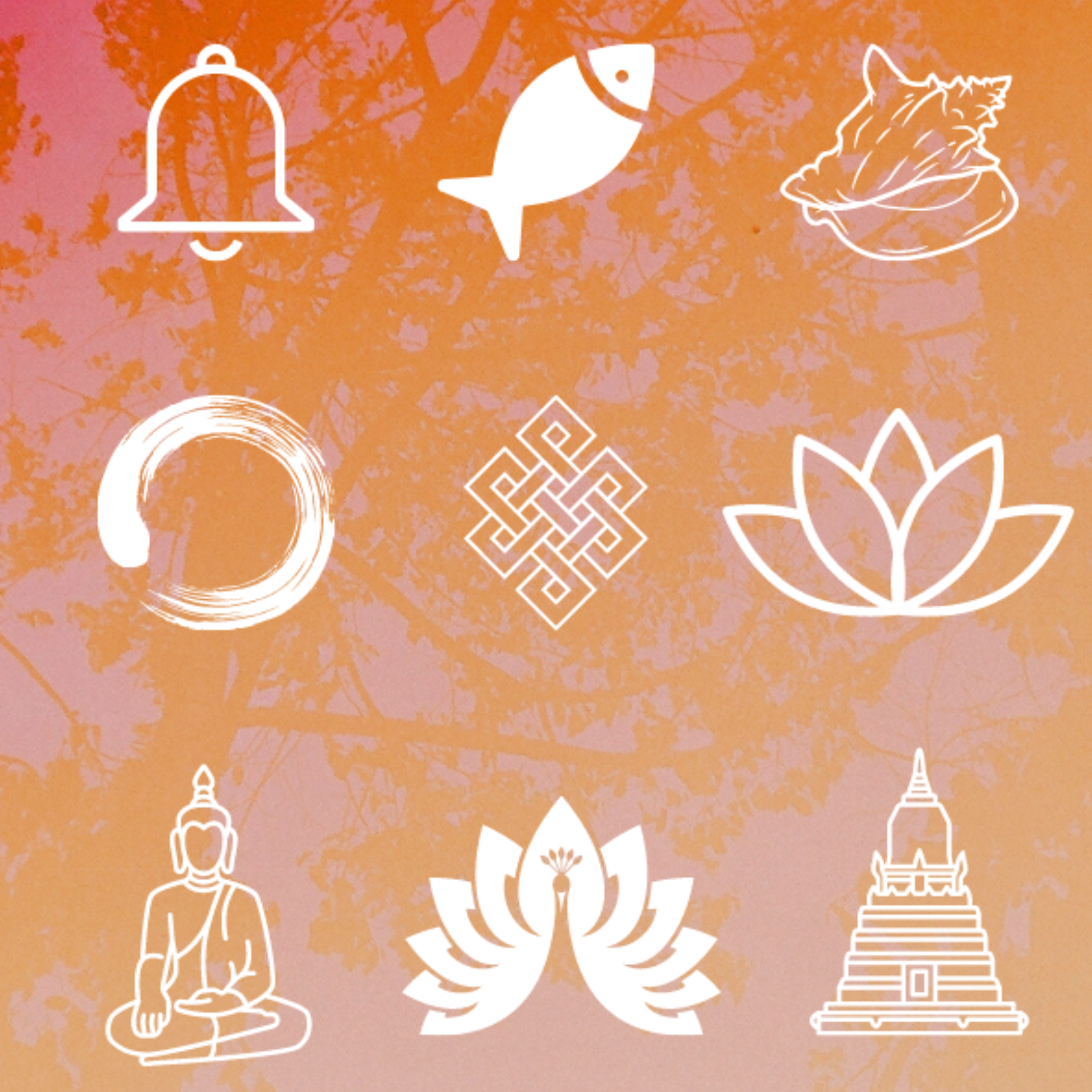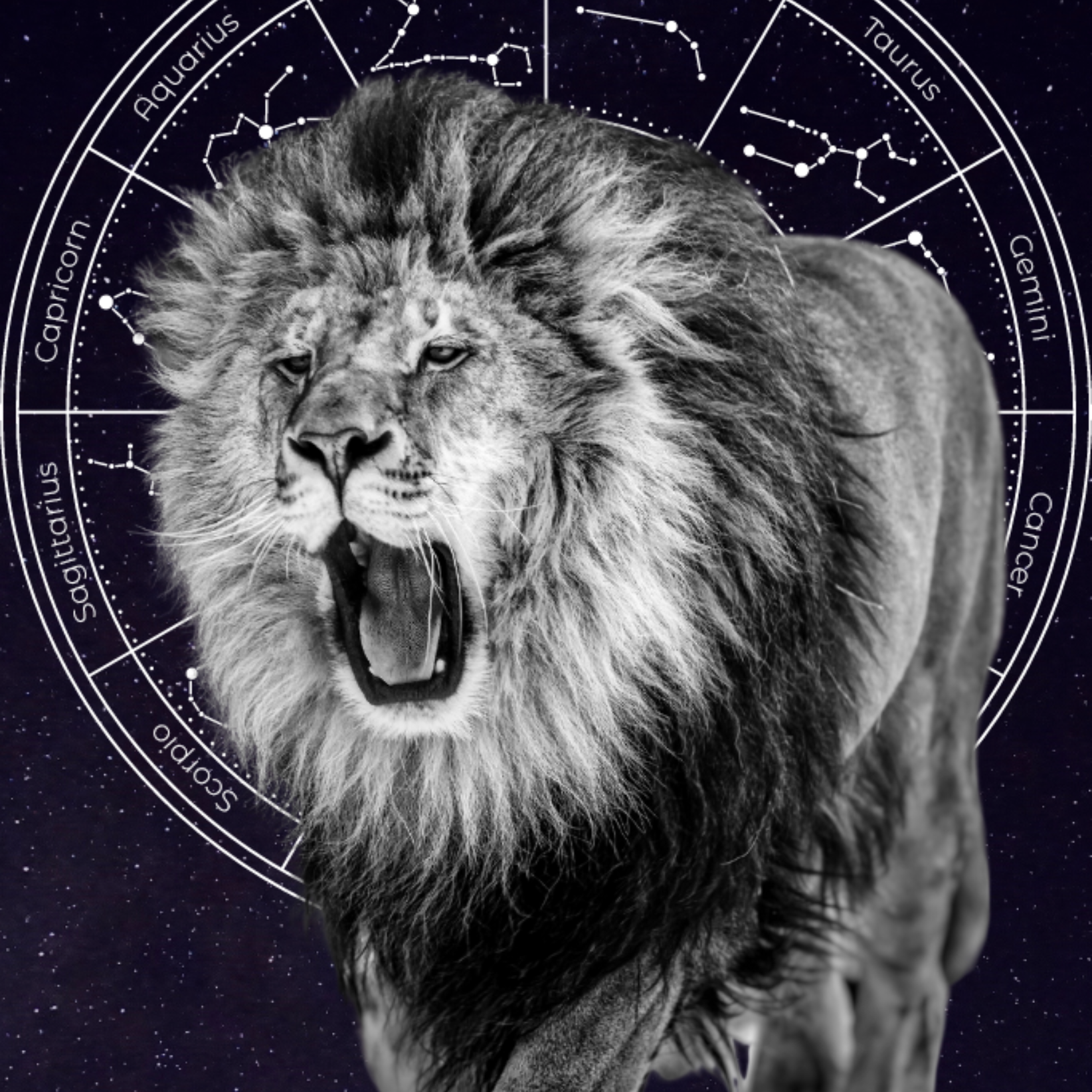Welcome to a fascinating exploration of symbols with this 44 Symbols of Enlightenment and Their Meanings article.
Throughout history, humans have sought higher understanding and transcendence, using symbols as gateways to the divine. We’ll discuss their sacred meanings, how you can incorporate their powerful messages into your daily life, and look at some cool tattoo ideas.
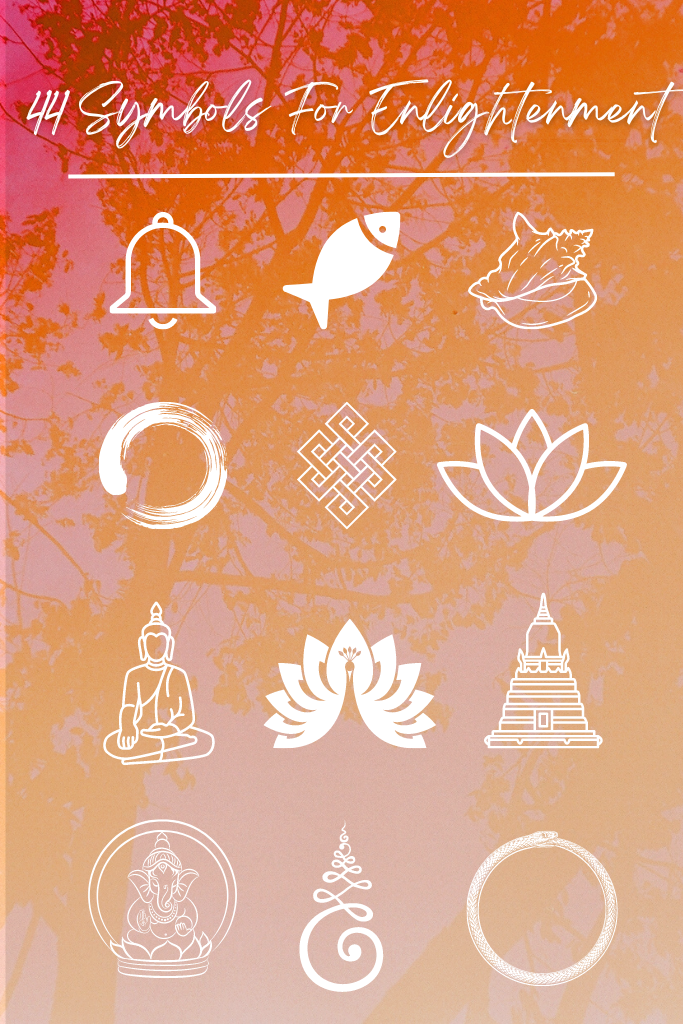
Let’s unravel 44 powerful symbols from various spiritual traditions, each carrying its own unique significance and wisdom, inviting you on a transformative journey of discovery and self-realization.
Ancient Tibetan Symbols and Meanings
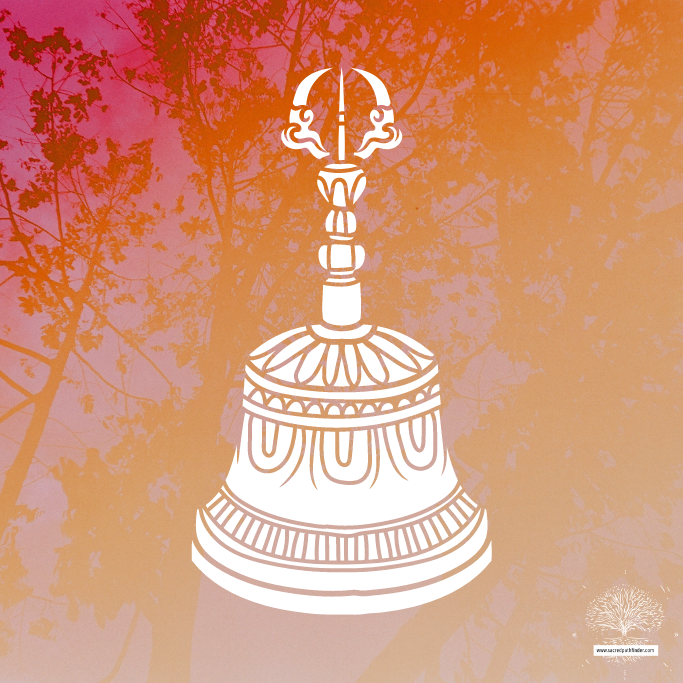
1. Bell or Gong
The Meaning
The Tibetan gong, also known as the bell, represents the primordial sound of creation, believed to connect practitioners with the ultimate truth and awakening. Its rounded shape symbolizes the infinite nature of existence.
The sound produced by striking the gong resonates with the vibrational harmony of the universe, purifying the mind and bringing forth a state of deep meditation.
As a potent tool for spiritual practitioners, the Tibetan gong serves as a reminder of the eternal journey toward enlightenment and the union of wisdom and compassion.
The Path
The Tibetan bell can be used as a tool for spiritual practice and enlightenment in daily life. To harness its power, incorporate the Tibetan bell into your daily rituals.
Begin by finding a quiet space for meditation. Hold the bell in your hands, taking a moment to connect with its energy. With focused intention, gently strike the bell, allowing its sound to resonate throughout your being. As the sound fades, let it draw your attention inward, inviting a state of deep presence and awareness.
The bell’s sound acts as a reminder to let go of distractions and connect with the present moment.
Throughout the day, whenever you feel the need for clarity or a moment of grounding, ring the bell and allow its sound to bring you back to the present. Embrace the peacefulness it offers and let it serve as a catalyst for inner reflection.
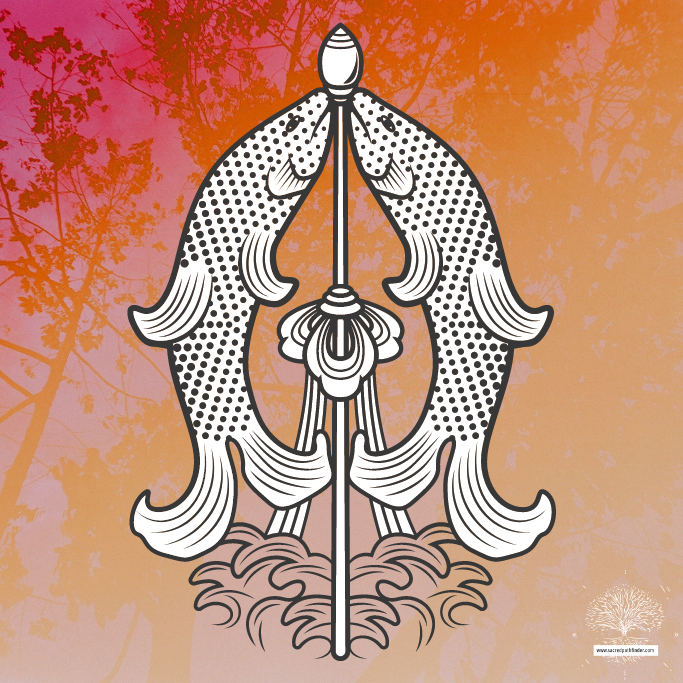
2. The Golden Fish
The Meaning
The Golden Fish has come to symbolize liberation from the ocean of suffering and the attainment of enlightenment. It represents fearlessness, adaptability, and the ability to navigate the turbulent waters of life with grace and wisdom.
Often depicted in pairs, the Golden Fish signifies the duality of wisdom and compassion, reminding practitioners of the interconnectedness of all beings and the importance of cultivating both qualities on the path to enlightenment.
The Path
To incorporate The Golden Fish’s symbolism into your daily life, create a visual representation of the Golden Fish or keep an image of it nearby.
Reflect on its meaning throughout the day, when faced with challenges or moments of uncertainty, and visualize the Golden Fish in your mind’s eye, drawing upon its qualities. Envision yourself embodying the attributes of fearlessness, adaptability, and resilience.
Allow the Golden Fish to inspire you to dive into life’s depths with courage and grace.

3. The Conch Shell
The Meaning
The Conch Shell is believed to embody the teachings of the Buddha, as the sound produced by the conch is said to awaken spiritual awareness and dispel ignorance.
It is often depicted as a sacred emblem, reminding practitioners to listen attentively to the teachings of the enlightened ones and to spread the message of compassion and wisdom to all corners of the world, just as the sound of the conch reverberates far and wide.
The Path
To utilize the power of the Conch Shell, familiarize yourself with the attributes associated with the Conch Shell, such as purity, wisdom, and the awakening of spiritual power.
Find a quiet space for reflection and hold a symbolic representation of the Conch Shell in your hand, visualizing its divine energy infusing your being.
Take a deep breath and blow into the symbolic shell, imagining the sound resonating throughout your entire being, clearing away any mental or emotional disturbances. Allow the sound to remind you of the power of your own inner voice and intuition.
Throughout the day, when faced with challenges or decisions, invoke the symbolism of the Conch Shell, drawing upon its wisdom and purity to guide your actions.
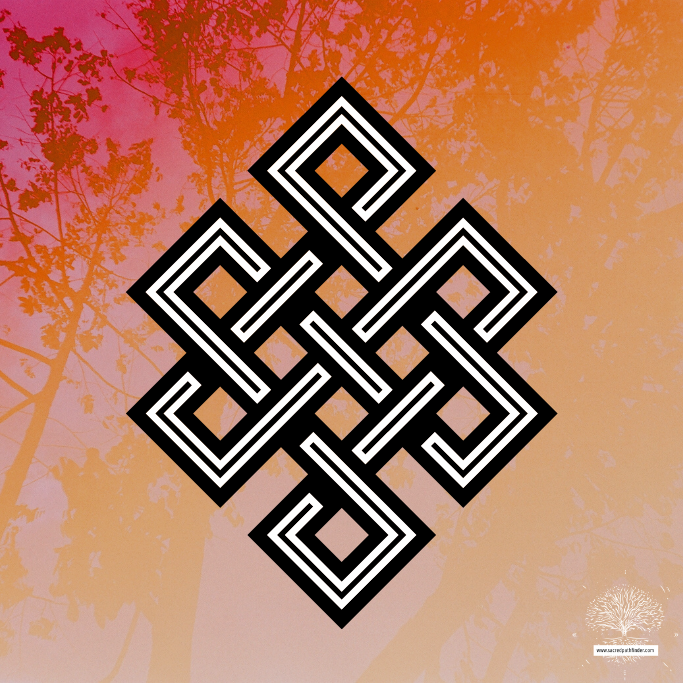
4. The Endless Knot
The Meaning
The Endless Knot, also known as the Eternal Knot or the Tibetan Knot, consists of intertwining lines that form a continuous pattern without a clear beginning or end.
This symbol represents the interconnectedness of all things and the infinite nature of reality. It embodies the concept of interdependence, illustrating that all phenomena are intricately connected and bound by an unbreakable unity.
The Endless Knot serves as a powerful reminder of the interplay between wisdom and compassion, encouraging practitioners to cultivate both qualities on their path to enlightenment.
The Path
To incorporate the symbol of the Endless Knot into your daily life, include it in your surroundings, such as wearing it as jewelry or placing an image of the Endless Knot in a visible location.
Throughout the day, whenever you encounter challenges or feel disconnected, take a moment to gaze at or touch the symbol, allowing it to serve as a reminder of the inherent interconnectedness of all existence.
Reflect on the wisdom and compassion that flow through your actions, embracing the unity of wisdom and compassion represented by the Endless Knot.
Engage in acts of kindness, extend compassion to others, and seek opportunities for personal growth and learning.
Ancient Buddist Symbols and Meanings
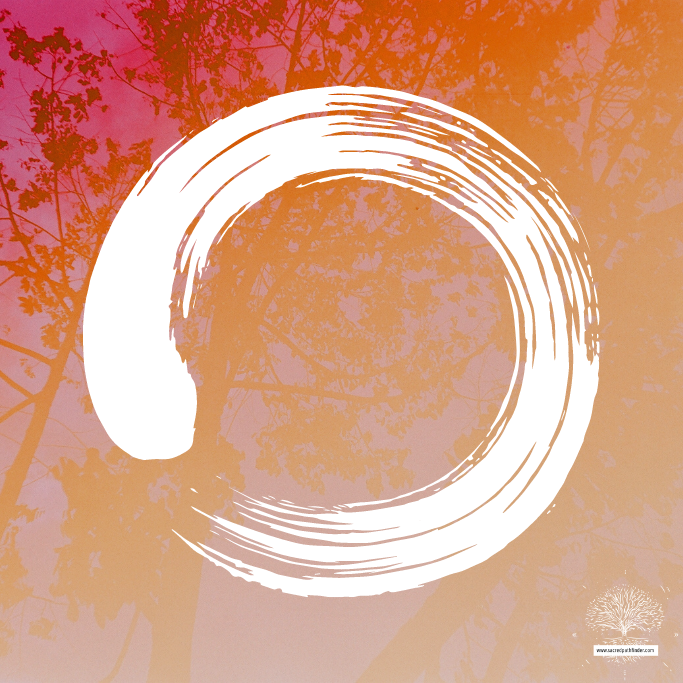
5. The Ensō
The Meaning
The Ensō is a captivating symbol that embodies the essence of enlightenment and the concept of the void. It is created with a single brushstroke. It represents the absolute, unbounded potential that exists within each individual and all of existence.
As a symbol of completion, wholeness, and the interconnectedness of all things, it signifies the realization of one’s true nature. The Ensō’s fluid and imperfect form also serves as a reminder of the impermanence of life and the beauty found in embracing the present moment.
The Path
To incorporate the Ensō into your daily life, find a quiet space for reflection and draw or visualize an Ensō in your mind’s eye. Contemplate the symbolism of the circle, representing the unity of existence and the limitless potential within.
As you go about your day, bring mindful awareness to the present moment, allowing the Ensō to remind you of the beauty and completeness in each experience. Embrace the concept of emptiness, letting go of attachment to outcomes and embracing the flow of life.
By integrating the symbolism of the Ensō into your daily life, you can move towards enlightenment by embracing the present moment, letting go of attachments, and experiencing the profound interconnectedness and unity of all things.

6. The Lotus
The Meaning
The Lotus is a revered symbol of enlightenment with deep roots in various ancient cultures and spiritual traditions.
In Buddhism, the Lotus represents the journey from darkness to light, mirroring the path of spiritual awakening. Emerging from muddy waters, the Lotus blooms immaculately, symbolizing purity, beauty, and the transcendence of worldly attachments.
It serves as a powerful reminder that, despite the challenges and difficulties of life, one can rise above and attain enlightenment, just as the Lotus rises above the murky depths to reveal its resplendent petals.
The Path
To use the power of the Lotus in your daily life, find a quiet space for reflection and visualize a beautiful Lotus flower blooming within your heart center.
One of my favorite ways to keep the lotus in my mind is by wearing jewelry with the lotus symbol.
As you go about your day, bring awareness to the qualities represented by the Lotus—purity, resilience, and the ability to rise above challenges.
Embody the Lotus’s grace, compassion, and serenity in your interactions with others and yourself. Allow the symbolism of the Lotus to inspire you to seek inner transformation, release negative emotions, and nurture your spiritual growth.
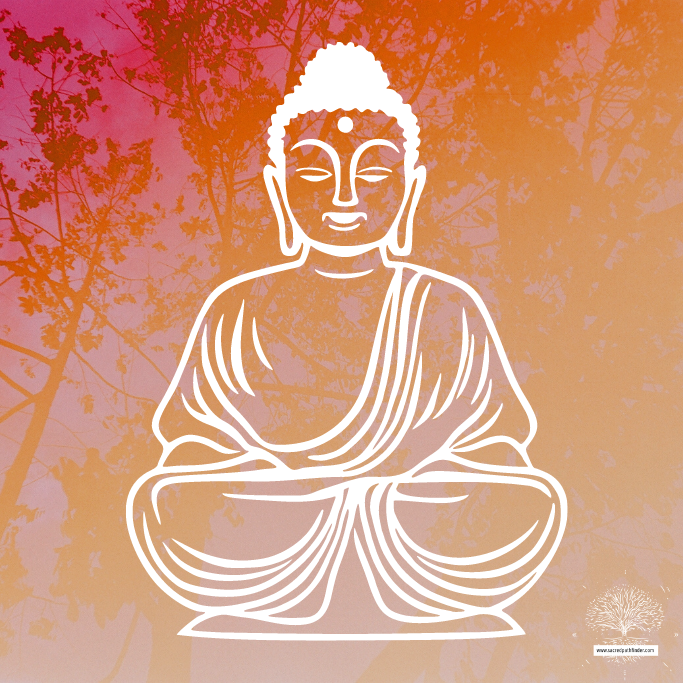
7. The Buddha
The Meaning
Originating from the teachings of Siddhartha Gautama, the historical figure who attained enlightenment and became the Buddha, this symbol represents the embodiment of awakened consciousness and supreme wisdom.
The symbol of the Buddha is one of the most revered and widely recognized symbols of enlightenment across various cultures and spiritual traditions.
The Buddha symbolizes the path of liberation from suffering and the realization of one’s true nature. It serves as a reminder of the potential for every individual to cultivate inner peace, compassion, and understanding.
The Path
The symbol of the Buddha, representing enlightenment and spiritual awakening, can serve as a powerful guide for personal growth and transformation in daily life.
To incorporate its symbolism, one can begin by developing a deep understanding of the Buddha’s teachings and the qualities he embodied, such as compassion, mindfulness, and wisdom.
Create a sacred space or altar dedicated to the Buddha, placing an image or statue in a prominent position. Engage in daily meditation or reflection, using the image of the Buddha as a focal point to cultivate inner stillness and clarity.
The symbol of the Buddha acts as a reminder of our inherent capacity for awakening and guides us on the path to ultimate liberation and spiritual fulfillment.
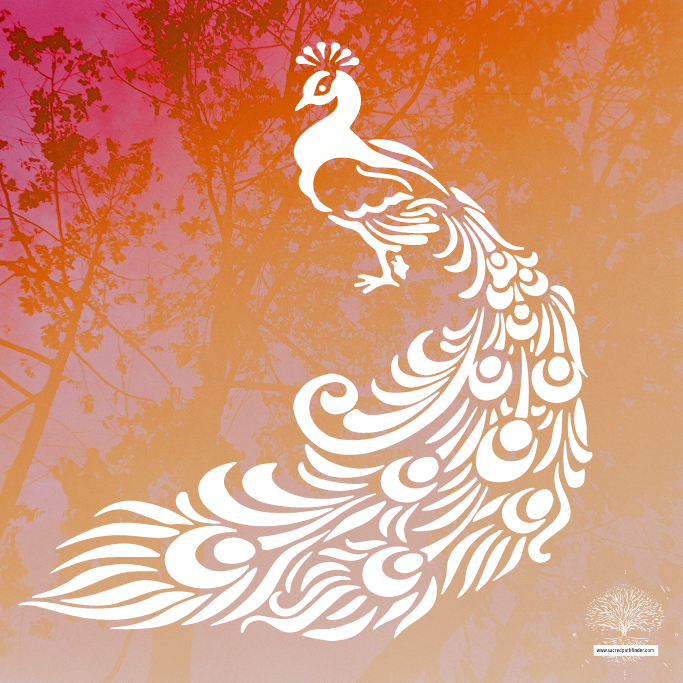
8. The Peacock
The Meaning
The Peacock holds a special place among the symbols of enlightenment, particularly in ancient Eastern cultures and spiritual traditions. With its vibrant plumage and graceful demeanor, the peacock symbolizes beauty, immortality, and spiritual transformation.
In Hinduism, the Peacock is associated with the deity Lord Murugan, who represents divine knowledge and wisdom.
In Buddhism, the Peacock is considered a guardian of the dharma, the teachings of the Buddha, symbolizing the ability to manifest one’s true potential.
The Peacock’s ability to display its magnificent feathers also represents the unveiling of one’s inner radiance.
The Path
Invite the symbol of the Peacock throughout the day by bringing mindful awareness to the beauty around you, allowing the Peacock’s symbol to remind you of the inherent beauty within yourself and all of creation.
Embrace integrity and authenticity in your actions, honoring your true essence and expressing your unique gifts. Cultivate a sense of wonder and awe, seeking to discover the divine in every moment.
The Peacock invites you to embody grace, confidence, and self-assurance as you navigate life’s challenges. By integrating the symbolism of the Peacock into your daily life, you can move towards enlightenment by embracing your inner beauty, expressing your authentic self, and cultivating a deep appreciation for the inherent divinity within and around you.
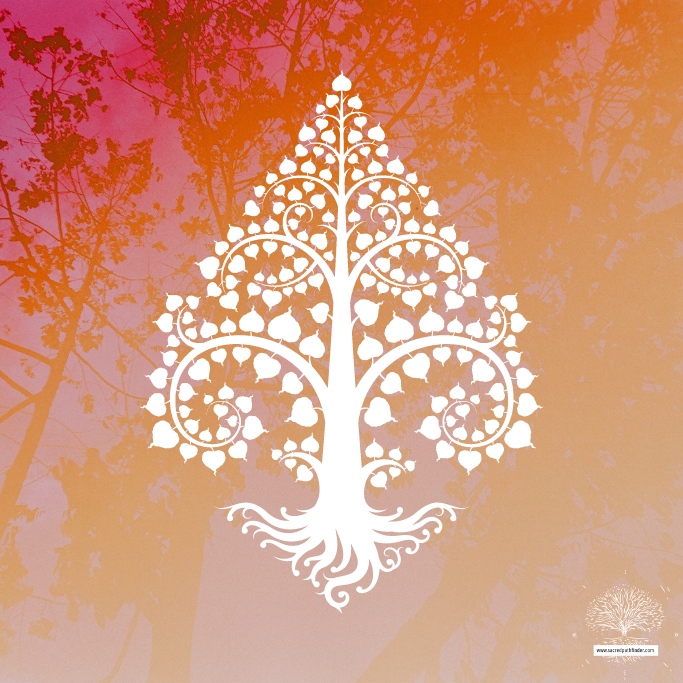
9. The Bodhi Tree
The Meaning
The Bodhi tree holds immense significance as a symbol of enlightenment, stemming from its association with the profound spiritual awakening of Siddhartha Gautama. This sacred fig tree represents the site where the Buddha attained enlightenment while meditating beneath its shelter.
The Bodhi tree symbolizes the potential for spiritual transformation and the realization of ultimate truth. Its expansive branches and deep-rooted presence signify the interconnectedness of all beings and the vastness of consciousness.
The Bodhi tree serves as a reminder of the power of contemplation in attaining enlightenment.
The Path
The symbol of the Bodhi Tree is deeply rooted in ancient wisdom. To incorporate its symbolism, create a space for contemplation and reflection, and visualize the Bodhi Tree in your mind’s eye.
Reflect on the qualities represented by the tree—strength, grounding, and the potential for growth and transformation.
Throughout the day, seek moments of stillness and connection with nature, allowing the symbolism of the Bodhi Tree to remind you of the importance of inner growth and self-discovery.
Engage in practices such as meditation, journaling, or spending time in nature to nurture your spiritual growth.
The symbol of the Bodhi Tree acts as a reminder to seek inner nourishment and connect with your roots.
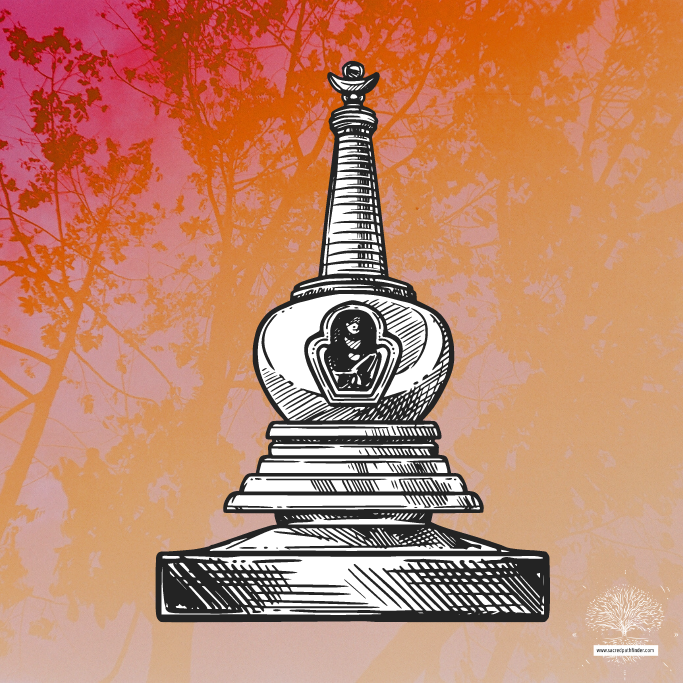
10. Stupa
The Meaning
The Stupa, a sacred symbol originating from ancient Buddhist traditions, holds profound significance in relation to enlightenment and spiritual awakening. It is a dome-shaped structure that serves as a place of meditation, prayer, and veneration.
The Stupa symbolizes the path to the enlightened mind. Its design embodies the cosmic axis, with the base representing the earthly realm, the dome representing the celestial realms, and the pinnacle symbolizing the ultimate realization of enlightenment.
The Stupa serves as a reminder of the Buddha’s teachings, the Four Noble Truths, and the Eightfold Path. By circumambulating the Stupa or meditating upon it, individuals can cultivate inner peace, deepen their spiritual practice, and awaken their innate Buddha nature.
The Path
To incorporate its symbolism, reflect on the architectural structure of the Stupa, which represents the enlightened mind and serves as a reminder of the ultimate truth.
Throughout the day, bring mindful awareness to your thoughts, words, and actions, seeking to align them with compassion, wisdom, and mindfulness.
Embrace the symbolism of the Stupa as a reminder to cultivate inner stillness, purify your mind, and let go of attachments.
Engage in practices such as meditation, chanting, or offering acts of kindness to create a sacred space within and around you.
By integrating the symbolism of the Stupa into your daily life, you can move towards enlightenment by cultivating inner peace, expanding your awareness, and transcending the limitations of the ego.
Ancient Indian Symbols and Meanings
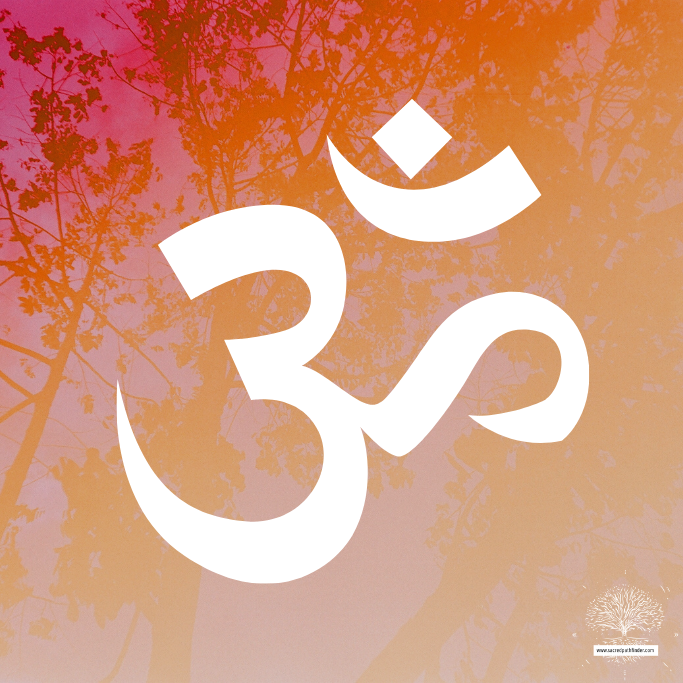
11. Om
The Meaning
The Om symbol represents the ultimate reality and the interconnectedness of all existence. It is considered the primordial sound of creation, representing the cosmic vibration that pervades the universe.
The symbol itself consists of three curves, a semicircle, and a dot, symbolizing the three states of consciousness (waking, dreaming, and deep sleep), the transcendence of duality, and the divine unity at the center.
The Path
The symbol of Om can serve as a transformative tool for personal growth. Create a sacred space for reflection and chant or recite the Om mantra, allowing its vibrations to resonate within you.
Embrace the sound of Om as a reminder of your connection to the universal consciousness and the interplay of creation and dissolution. Throughout the day, bring mindful awareness to your breath, allowing each inhalation and exhalation to be an embodiment of Om.
Embrace the present moment fully, recognizing the divine presence within yourself and all beings.
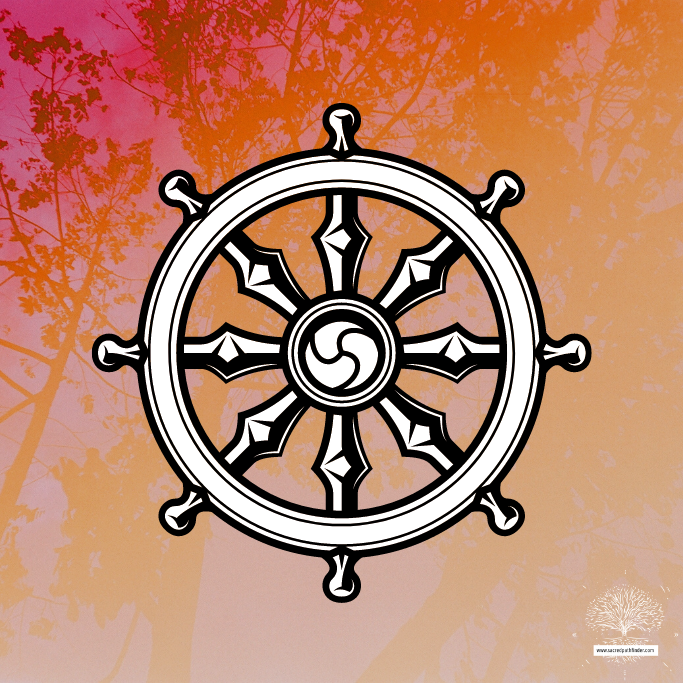
12. The Wheel of Dharma
The Meaning
The Dharma Wheel, also known as the Dharmachakra, is a potent symbol of enlightenment with roots in ancient Indian and Buddhist traditions.
The wheel’s circular shape symbolizes the endless cycle of birth, death, and rebirth, while its eight spokes signify the Noble Eightfold Path, which leads to enlightenment.
The Dharma Wheel serves as a reminder of the interconnectedness of all things and the importance of living in alignment with ethical conduct, mindfulness, and wisdom.
By turning the wheel of Dharma, practitioners seek to awaken their true nature and break free from the cycle of suffering.
The Path
To incorporate its symbolism, reflect on the Noble Eightfold Path and the Four Noble Truths, which form the foundation of the Wheel of Dharma.
Throughout the day, bring mindful awareness to your thoughts, words, and actions, aligning them with the principles of the Eightfold Path—right understanding, intention, speech, action, livelihood, effort, mindfulness, and concentration.
Embrace the teachings of the Wheel of Dharma as a guide for ethical conduct, compassion, and the pursuit of wisdom.
Engage in practices such as meditation, contemplation, and study of sacred texts to deepen your understanding of the Dharma.
The symbol of the Wheel of Dharma acts as a reminder to stay on the path of self-realization, engage in compassionate action, and discover the true nature of existence.
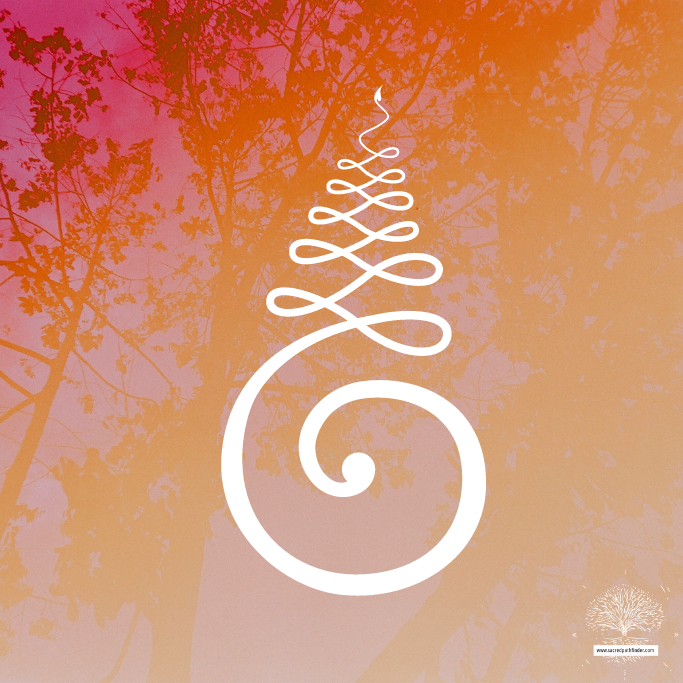
13. Unalome
The Meaning
The Unalome symbol resembles a spiral with a straight line running through it, often depicted with lotus petals or other sacred elements.
The spiral represents the twists and turns of life’s challenges and experiences, while the straight line represents the path to enlightenment.
As one moves along the spiral, overcoming obstacles and gaining wisdom, they gradually ascend towards the straight path, representing the attainment of enlightenment.
The Unalome symbol serves as a reminder that the journey toward enlightenment is unique to each individual and that self-realization is attainable despite life’s complexities.
The Path
To incorporate the Unalome into your daily life, visualize the symbol, and remember that it represents the twists and turns of life’s challenges and the path towards higher consciousness.
Throughout the day, bring mindful awareness to your thoughts, emotions, and actions, observing the ups and downs with non-judgment and compassion. Embrace the symbolism of the Unalome as a reminder that the journey toward enlightenment is not linear but filled with growth and learning.
Engage in practices such as meditation, self-reflection, and self-inquiry to deepen your understanding of the self and the nature of reality. This symbol acts as a reminder to stay committed to the path of self-realization, navigate life’s challenges with grace, and embrace the transformative power of the spiritual journey.
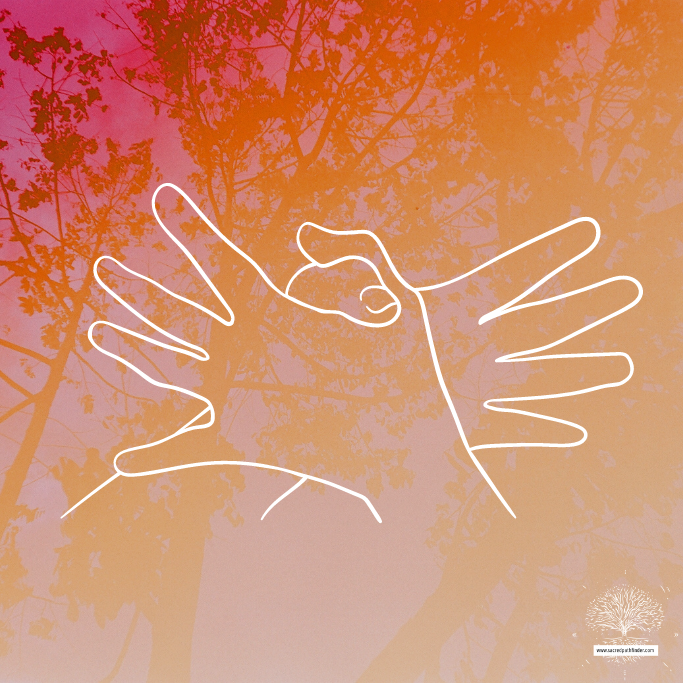
14. Garuda Mudra
The Meaning
The Garuda Mudra is a sacred hand gesture that holds deep significance in the realm of spiritual enlightenment. Originating from Hindu and Buddhist traditions, it is associated with the mythical creature Garuda, symbolizing power, protection, and liberation.
The Garuda Mudra is formed by interlocking the fingers with the thumbs extended upwards, resembling the wings of Garuda. This mudra represents the transcendence of negative energies and obstacles, allowing one to soar beyond limitations on the path to spiritual liberation.
It signifies the cultivation of strength, fearlessness, and the ability to overcome challenges and soar to higher realms of consciousness. The Garuda Mudra serves as a potent tool for practitioners, helping them connect with their inner power and channel divine energy in their pursuit of enlightenment.
The Path
To incorporate this symbol into a daily ritual, find a quiet space for reflection and assume a comfortable seated position. Bring your hands together in front of your heart, interlocking your fingers with the palms facing outward. Extend your thumbs upward, symbolizing the wings of the Garuda bird.
As you hold this mudra, close your eyes and connect with the energy of the Garuda, envisioning yourself soaring above challenges and limitations.
Throughout the day, whenever you encounter obstacles or feel a sense of heaviness, bring your hands into the Garuda Mudra, grounding yourself in its symbolism of strength and protection.
Embrace the qualities represented by the Garuda—courage, resilience, and freedom—inspiring you to overcome obstacles on your spiritual journey. The Garuda Mudra acts as a reminder to tap into your inner power and soar toward spiritual liberation.
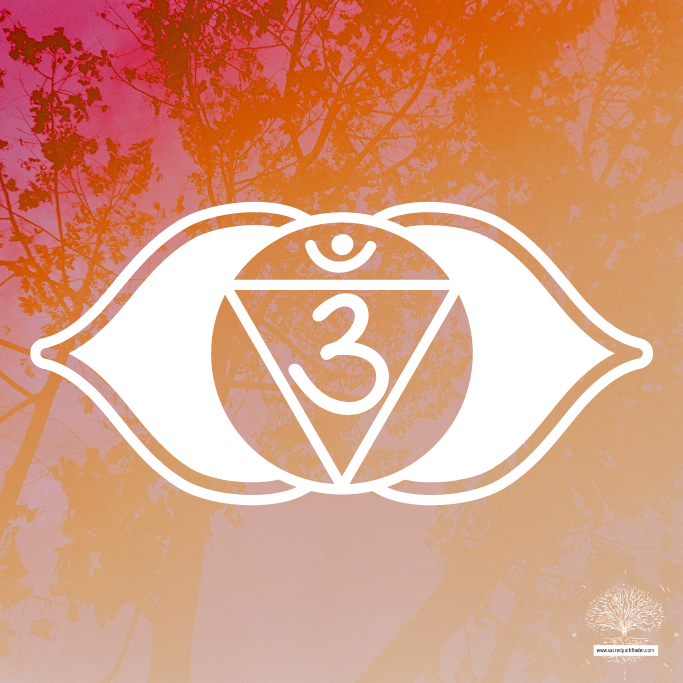
15. Third Eye Chakra
The Meaning
The Third Eye Chakra, also known as the Ajna Chakra, is a symbol of spiritual awakening and intuition deeply rooted in ancient Indian spiritual traditions, particularly in the practice of yoga and meditation.
Located in the center of the forehead, it represents the gateway to higher consciousness. The Third Eye Chakra is associated with clarity, intuition, and psychic perception. Opening and balancing this chakra allows individuals to access their innate spiritual insight, enhancing their ability to perceive the subtle dimensions of reality beyond the physical realm.
The Third Eye Chakra serves as a guide on the path of spiritual evolution, encouraging practitioners to explore their inner depths and tap into the unlimited potential of their consciousness.
The Path
To incorporate this symbol into your daily rituals, find a quiet space for reflection and assume a comfortable seated position. Close your eyes and bring your attention to the space between your eyebrows, which is believed to be the location of the Third Eye Chakra.
Visualize a radiant indigo light glowing at this point, symbolizing the awakened Third Eye.
Throughout the day, bring mindful awareness to your inner guidance and intuition, trusting the wisdom that arises from within. You can burn incense as a reminder to slow down and reconnect to the third eye.
Embrace practices such as meditation, visualization, and breathwork to activate and balance the Third Eye Chakra.
Engage in activities that stimulate your imagination and foster creativity.
By integrating the symbolism of the Third Eye Chakra into your daily life, you can move towards enlightenment by cultivating inner clarity, accessing higher wisdom, and deepening your spiritual connection.
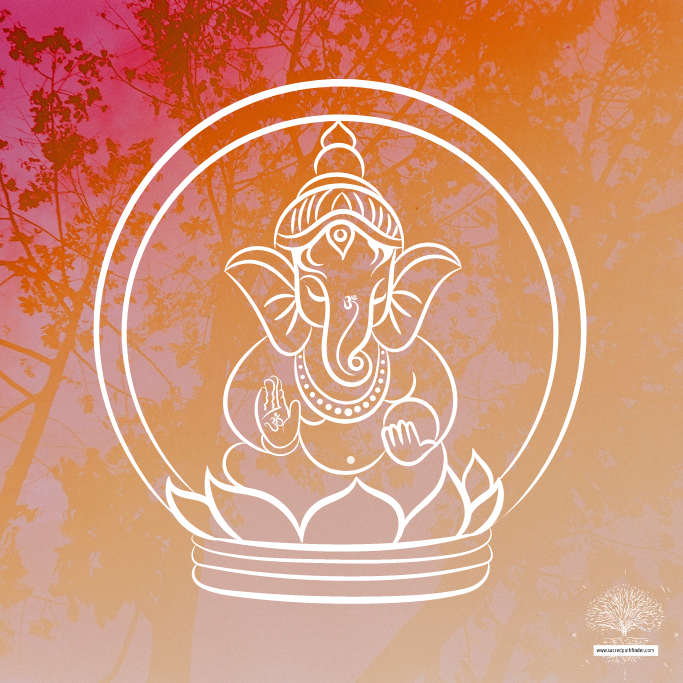
16. Ganesh
The Meaning
Ganesh, also known as Ganapati, is a revered symbol of enlightenment in Hinduism with ancient origins. As the deity of wisdom, intellect, and remover of obstacles, Ganesh is highly venerated and widely recognized for his distinct elephant head and human body.
His unique appearance symbolizes the harmony between the animal and divine nature within each individual. Ganesha’s large ears represent attentive listening to spiritual teachings, while his broken tusk signifies sacrifice and the renunciation of worldly desires.
Ganesha’s presence is believed to grant blessings, pave the way for success, and guide seekers on their path toward spiritual enlightenment.
As the lord of beginnings, Ganesha inspires devotees to overcome obstacles, embrace knowledge, and awaken their inner divine potential.
The Path
To incorporate Ganesh’s symbolism, find a quiet space for reflection and set up a small shrine or altar dedicated to Ganesh.
Place an image or statue of Ganesh in a prominent position. Engage in a daily ritual of offering prayers, incense, or flowers to Ganesh, expressing gratitude and seeking his blessings.
Throughout the day, whenever faced with challenges or obstacles, invoke the energy of Ganesh, calling upon his wisdom and guidance.
Embrace the symbolism of Ganesh as the remover of obstacles, both internal and external, and seek his assistance in overcoming hurdles on your spiritual path.
By integrating the symbolism of Ganesh into your daily life, you can move towards enlightenment by cultivating inner strength, overcoming obstacles, and fostering a deep connection with divine wisdom.

17. Namaste
The Meaning
The Namaste gesture, originating from ancient Indian traditions, is a profound symbol of respect, honor, and spiritual connection. The word “Namaste” derives from Sanskrit and translates to “I bow to you” or “the divine in me recognizes the divine in you.”
The gesture is typically performed by pressing the palms together in front of the heart chakra and bowing the head.
Namaste symbolizes the recognition and reverence of the divine spark within every being, transcending differences and embracing the inherent unity of all existence.
Namaste is a reminder of the deep respect for the sacredness of life and the potential for spiritual growth within each individual. By offering Namaste, individuals honor the divine essence in others and invite a sense of harmony, compassion, and peace into their interactions and the world.
The Path
To incorporate its symbolism, reflect on the essence of Namaste, which signifies “the divine in me bows to the divine in you.”
Throughout the day, bring mindful awareness to your interactions with others, seeking to see the divine essence within each being you encounter.
Embrace the symbolism of Namaste as a reminder to honor the inherent sacredness in every person and to approach each interaction with love, compassion, and respect.
Engage in practices such as meditation, mantra recitation, or conscious breathing to cultivate a deep sense of connection with the divine within and around you.
By integrating the symbolism of Namaste into your daily life, you can move towards enlightenment by fostering unity, cultivating a sense of oneness, and honoring the divine in all aspects of existence
Ancient Celtic Symbols and Meanings
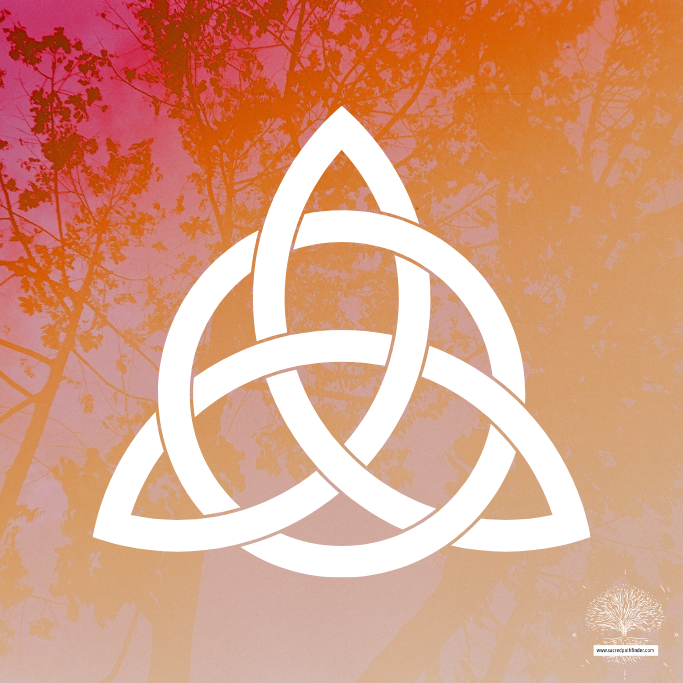
18. The Celtic Knot
The Meaning
The Celtic Knot, also known as the Celtic Love Knot or the Mystic Knot, is a symbol originating from the ancient Celtic culture of Ireland, Scotland, and Wales.
This intricate, interwoven design represents the eternal nature of life and the interconnectedness of all things. Its continuous looping pattern symbolizes the cycle of birth, death, and rebirth, reflecting the Celtic belief in the cyclical nature of existence.
The Celtic Knot also signifies unity, harmony, and the interplay of physical, mental, and spiritual aspects of life. It serves as a reminder of the eternal quest for enlightenment.
The Celtic Knot is a visual representation of the unbreakable bond between humanity, nature, and the divine, inspiring individuals on their spiritual journey toward enlightenment.
The Path
The Celtic Knot, a sacred symbol with a rich history, can be a transformative tool for personal growth and enlightenment in daily life.
To incorporate its symbolism, find a quiet space for reflection and focus on a visual representation of the Celtic Knot. Meditate on its intricate and continuous patterns, symbolizing the eternal flow of energy.
Engage in practices such as journaling, creative expression, or nature walks to deepen your connection to the cycles of life and the world around you.
By integrating the symbolism of the Celtic Knot into your daily life, you can move towards enlightenment by cultivating awareness of interconnectedness, embracing the beauty of impermanence, and appreciating the intricate tapestry of existence.
Ancient Egyptian Symbols and Meanings

19. Ouroboros
The Meaning
The Ouroboros, a symbol deeply rooted in ancient Egyptian, Greek, and alchemical traditions, represents the eternal cycle of life, death, and rebirth.
It portrays a serpent or dragon devouring its own tail, forming a continuous loop. This symbolizes the infinite nature of existence and the cyclical process of creation and destruction.
The Ouroboros embodies the concept of unity, wholeness, and the eternal interconnectedness of all things. It signifies the journey of self-discovery, urging individuals to confront their own shadow aspects and embrace the process of inner alchemy.
The Path
To incorporate its symbolism, reflect on the image of the serpent or dragon and the meaning behind the symbol.
Throughout the day, bring mindful awareness to the patterns and cycles in your life, recognizing the interplay of beginnings and endings.
Engage in practices such as self-reflection, meditation, or journaling to deepen your understanding of your own cycles and patterns. I also love wearing this symbol. Check out this bracelet using the Ouroboros symbol.
By integrating the symbolism of the Ouroboros into your daily life, you can move towards enlightenment by embracing the cyclical nature of existence, transcending limitations, and experiencing the transformative power of self-discovery.
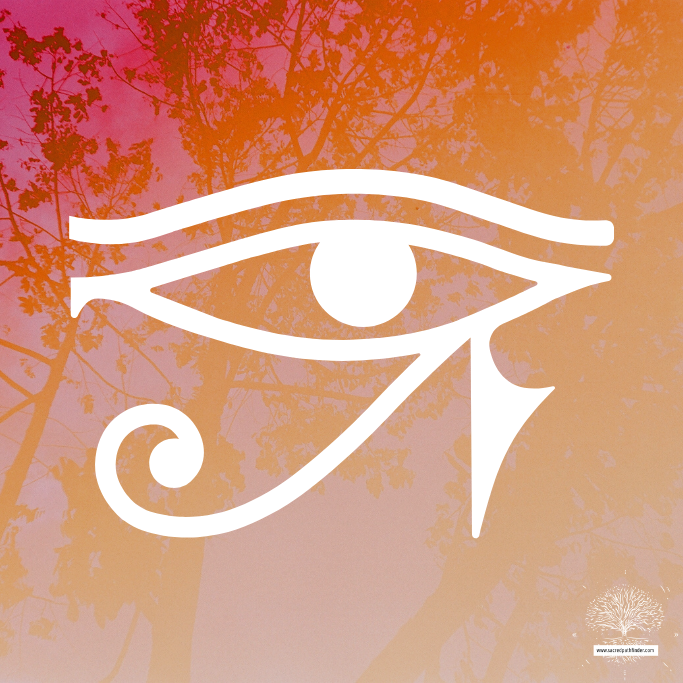
20. Eye of Horus
The Meaning
The Eye of Horus, also known as the Udjat or the Wadjet Eye, has its origins in ancient Egyptian mythology and represents enlightenment, protection, and divine vision.
It is a symbol associated with Horus, the falcon-headed god of the sky, and divine kingship. The Eye of Horus symbolizes the power of healing, restoration, and protection against evil forces. It also represents the all-seeing eye of spiritual awareness, providing clarity and insight into hidden truths and mysteries.
The Eye of Horus serves as a reminder of the eternal presence of divine wisdom and the pursuit of enlightenment, guiding individuals to align with their higher selves and transcend the limitations of the physical world.
The Path
To incorporate its symbolism, one can begin by understanding the profound meaning associated with the Eye of Horus, such as protection, healing, and spiritual insight. Reflect on the image of the eye, symbolizing the all-seeing eye of divine consciousness.
Throughout the day, bring mindful awareness to your intuition, trusting in your inner guidance. Embrace the symbolism of the Eye of Horus as a reminder of your connection to divine wisdom and the protection it offers on your spiritual path.
Engage in practices such as meditation, visualization, or energy healing to awaken and activate your inner vision.
By integrating the symbolism of the Eye of Horus into your daily life, you can move towards enlightenment by cultivating inner clarity, accessing higher wisdom, and deepening your spiritual connection.

21. Infinity
The Meaning
The Infinity symbol, also known as the Lemniscate, has a rich history and profound symbolism in various ancient cultures. Its origins can be traced back to ancient Egypt, where it was associated with concepts of eternal life and cosmic balance.
The symbol resembles a figure-eight lying on its side, representing the infinite and interconnected nature of existence.
It symbolizes the timeless nature of consciousness, the endless cycle of birth and death, and the harmony between opposing forces.
The Infinity symbol invites individuals to contemplate the limitless possibilities of the universe and the boundless potential within themselves. It serves as a reminder of the interconnectedness of all things and the perpetual journey toward self-realization.
The Path
To incorporate its symbolism, reflect on the image of the horizontal figure-eight, symbolizing the infinite and continuous flow of energy.
Throughout the day, bring mindful awareness to the present moment, recognizing the infinite possibilities within each moment.
Embrace the symbolism of Infinity as a reminder to release limitations, expand your consciousness, and embrace the vastness of your true nature.
Engage in practices such as meditation, breathwork, or affirmations to cultivate a sense of expansiveness and connection with the infinite.
Embody the qualities represented by Infinity, such as openness, acceptance, and the recognition of the divine in all things, in your thoughts, actions, and relationships.
By integrating the symbolism of Infinity into your daily life, you can move towards enlightenment by embracing the infinite potential within yourself and in the world around you, transcending limitations, and aligning with the eternal nature of existence.
Ancient Greek Symbols and Meanings
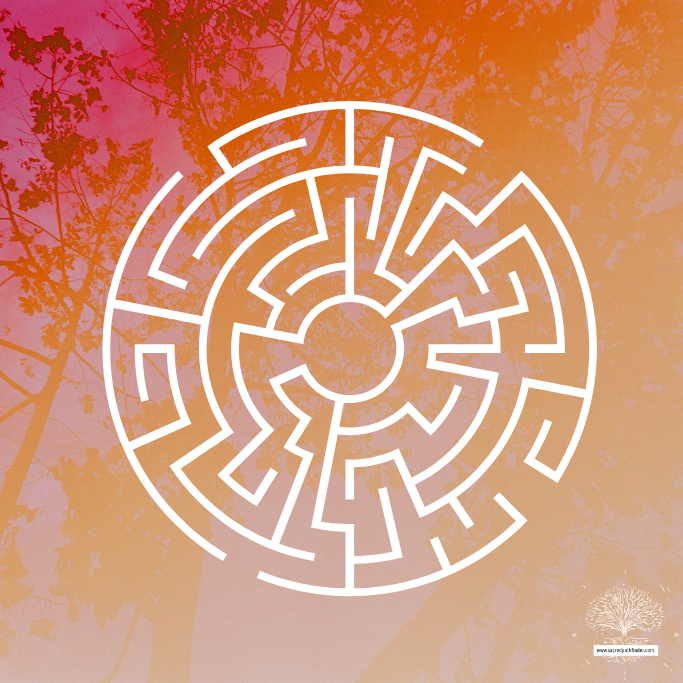
22. Labyrinth
The Meaning
The Labyrinth, a symbol with ancient origins found in various cultures, represents the journey of self-discovery.
Its intricate design consists of a winding, maze-like path leading to a central point. The labyrinth is not meant to confuse or trap, but rather to serve as a meditative tool for reflection and contemplation.
It symbolizes the twists and turns of life’s journey and the search for inner truth and enlightenment. Walking the labyrinth is a metaphor for navigating the complexities of the mind and finding one’s center. It represents the process of letting go, surrendering, and embracing the present moment.
The labyrinth serves as a reminder that the path to enlightenment is not always linear but filled with opportunities for growth. By journeying through the labyrinth, individuals embark on a transformative quest, discovering the profound wisdom that lies within.
The Path
To incorporate its symbolism, visualize the winding path of the Labyrinth, representing the twists and turns of life’s journey.
Throughout the day, bring mindful awareness to your own inner journey, embracing both challenges and opportunities for growth.
Reflect on your experiences and choices, seeking to uncover deeper truths and insights.
Engage in practices such as meditation, contemplation, or walking a physical labyrinth to enhance your connection with the symbolism of the Labyrinth.
Embody the qualities represented by the Labyrinth, such as patience, perseverance, and surrender, as you navigate your daily challenges.
By integrating the symbolism of the Labyrinth into your daily life, you can move towards enlightenment by embracing self-exploration, seeking inner harmony, and finding your own unique path to spiritual truth.

23. Butterfly
The Meaning
The Butterfly, a symbol found in various ancient cultures, represents spiritual metamorphosis. Its origin as a symbol of enlightenment can be traced back to ancient Greek and Roman mythology, where it was associated with the soul and immortality.
The butterfly’s life cycle from caterpillar to chrysalis to butterfly mirrors the journey of spiritual awakening and the evolution of consciousness.
The butterfly symbolizes the shedding of old limitations, embracing change, and the emergence of one’s true self. It serves as a reminder of the beauty that can arise from challenging transitions and the potential for personal growth.
The butterfly’s delicate and graceful presence inspires individuals to embrace their own transformative journeys, let go of attachments, and embrace the freedom and joy that come from aligning with their authentic nature.
The Path
To incorporate its symbolism, reflect on the image of the Butterfly, symbolizing the journey from caterpillar to chrysalis to the emergence of a beautiful winged creature.
Throughout the day, bring mindful awareness to your own process of growth and transformation. Embrace the symbolism of the Butterfly as a reminder to embrace change, let go of limitations, and step into your true potential.
Engage in practices such as journaling, self-reflection, or creative expression to explore your own personal journey of transformation.
Embody the qualities represented by the Butterfly, such as grace, resilience, and the willingness to embrace the unknown, in your thoughts, actions, and relationships.
By integrating the symbolism of the Butterfly into your daily life, you can move towards enlightenment by embracing the transformative power of self-discovery, cultivating inner beauty, and aligning with the natural cycles of life.
We found these temporary tattoos that look just like real tattoos with the butterfly symbol that we have to try.
Ancient Chinese Symbols and Meanings
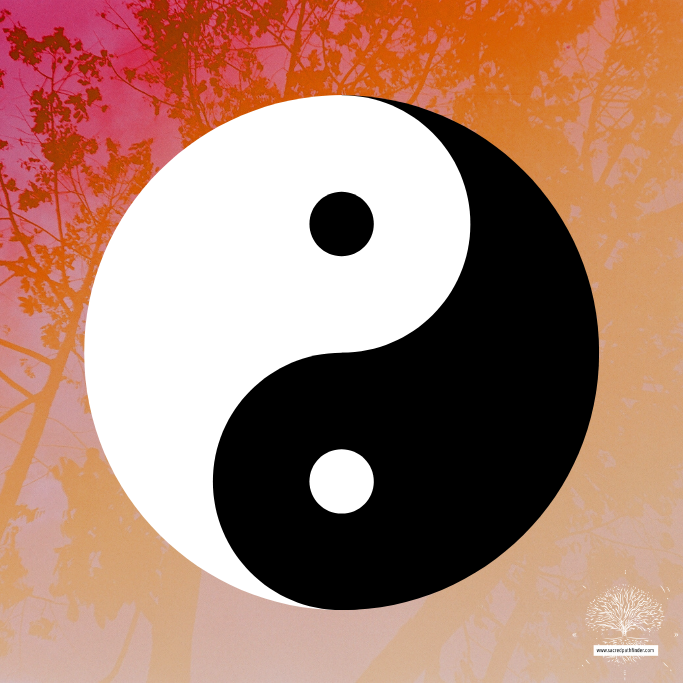
24. Yin Yang
The Meaning
The Yin Yang symbol, originating from ancient Chinese philosophy and Taoism, embodies the harmony and balance of opposing forces within the universe.
The symbol consists of two interlocking teardrop-shaped halves, one white (yang) and one black (yin), each containing a small dot of the opposite color. Yin represents the feminine, passive, and receptive aspects, while yang represents the masculine, active, and assertive qualities.
The symbol conveys the interconnectedness and interdependence of these opposing forces, illustrating that they are complementary and inseparable. The dot within each half signifies the potential for transformation and the presence of the opposing force within its counterpart.
The Yin Yang symbol reminds individuals of the inherent duality and harmony present in all aspects of existence. It encourages embracing both light and shadow, and recognizing that harmony is achieved through integration of opposing forces.
The Path
To incorporate its symbolism, reflect on the image of the black and white halves, representing the complementary and interconnected nature of the universe.
Throughout the day, bring mindful awareness to the balance of opposing energies within yourself and in your interactions with others.
Embrace the symbolism of the Yin Yang as a reminder of the dynamic interplay between light and dark, masculine and feminine, and other dualities.
Engage in practices such as meditation, breathwork, or tai chi to cultivate a sense of balance within. Embody the qualities represented by the Yin Yang, such as adaptability, acceptance, and embracing change, in your thoughts, actions, and relationships.
By integrating the symbolism of the Yin Yang into your daily life, you can move towards enlightenment by cultivating inner balance, embracing the unity of all things, and finding harmony amidst the ever-changing nature of existence.

25. Dragon
The Meaning
The Dragon symbol holds multifaceted meanings, including enlightenment and spiritual transformation. In many Eastern traditions, the dragon symbolizes power, wisdom, and the connection between heaven and earth.
It is often associated with the Kundalini energy, representing the dormant spiritual potential within every individual. The dragon’s serpentine form and ability to fly symbolize the journey of the soul, ascending from the earthly realm to higher levels of consciousness.
The dragon’s fiery nature signifies the transformative power of spiritual awakening, as it purifies and illuminates the path to enlightenment. The Dragon serves as a potent symbol for those seeking inner growth and self-realization, reminding individuals of their innate divine essence and inviting them to harness the dragon’s transformative energy on their quest for enlightenment.
The Path
To incorporate the symbolism of the Dragon into your daily life, reflect on the image of the Dragon, symbolizing primal energy, strength, and cosmic forces.
Throughout the day, bring mindful awareness to your own inner power and vitality, harnessing the qualities represented by the Dragon.
Embrace the symbolism of the Dragon as a reminder to embrace your passions and desires, channeling them towards positive and transformative endeavors.
Engage in practices such as meditation, visualization, or breathwork to connect with the energy of the Dragon. Embody the qualities represented by the Dragon, such as courage, resilience, and wisdom, as you navigate your daily challenges.
By integrating the symbolism of the Dragon into your daily life, you can move towards enlightenment by harnessing your inner power, embracing transformation, and aligning with the cosmic flow of existence.
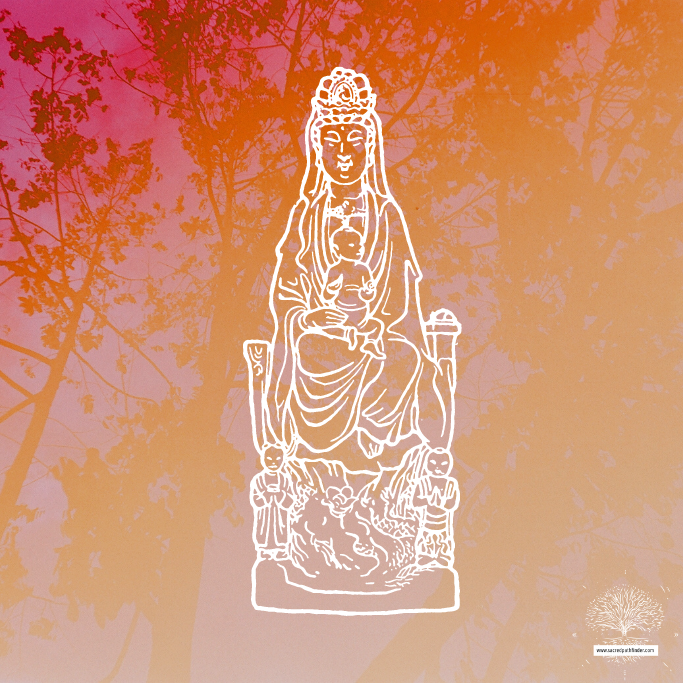
26. Kuan Yin
The Meaning
Kuan Yin, also known as Guanyin or Avalokiteshvara, is a revered symbol of compassion, mercy, and enlightenment in various Eastern spiritual traditions, particularly in Buddhism.
Originating from ancient Chinese and East Asian cultures, Kuan Yin is depicted as a bodhisattva, an enlightened being who chooses to remain in the realm of existence to assist others in their spiritual journey.
Kuan Yin represents the embodiment of boundless compassion and loving-kindness, offering solace and guidance to those in need. The symbol of Kuan Yin serves as a reminder of the path of selfless service, empathy, and unconditional love.
By embodying Kuan Yin’s qualities, individuals are encouraged to cultivate compassion towards themselves and others, fostering unity and awakening their own innate Buddha nature. Kuan Yin’s presence inspires practitioners to strive for enlightenment and to alleviate suffering in the world through acts of compassion.
The Path
To incorporate its symbolism, reflect on the image of Kuan Yin, representing the boundless love and healing energy of the divine feminine.
Throughout the day, bring mindful awareness to acts of kindness and compassion, both towards yourself and others.
Embrace the symbolism of Kuan Yin as a reminder to cultivate empathy, forgiveness, and unconditional love in all aspects of your life.
Engage in practices such as meditation, prayer, or chanting of Kuan Yin’s mantra to connect with her compassionate energy and invoke her blessings.
Embody the qualities represented by Kuan Yin, such as patience, gentleness, and the desire to alleviate suffering, in your thoughts, actions, and relationships.
By integrating the symbolism of Kuan Yin into your daily life, you can move towards enlightenment by nurturing compassion, deepening your spiritual connection, and fostering unity and harmony in the world.
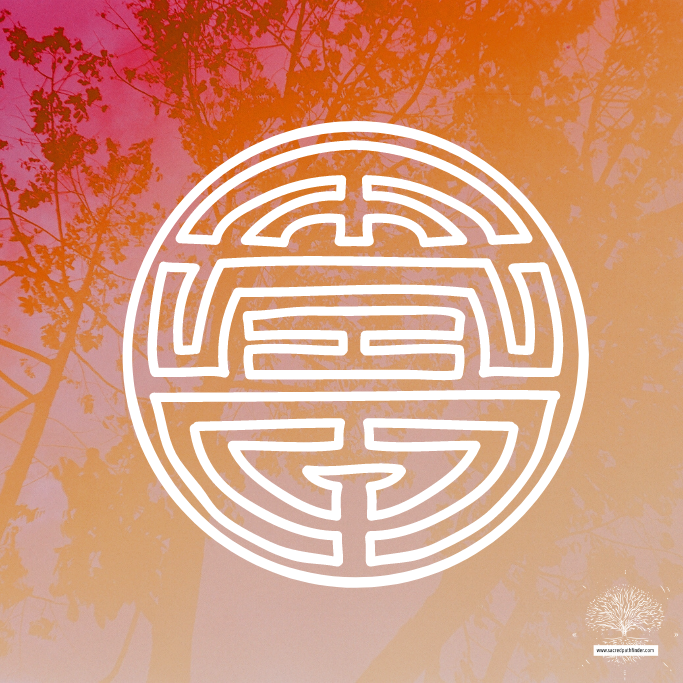
27. Shou
The Meaning
The Shou symbol, also known as the Longevity symbol, has its origins in ancient Chinese culture and carries deep meaning related to longevity, health, and spiritual well-being. Represented by a stylized calligraphic character, the Shou symbolizes the pursuit of a long and fulfilling life.
It embodies the balance of yin and yang energies, the harmony of mind, body, and spirit, and the cultivation of inner virtues.
The Shou symbol is associated with wisdom, vitality, and the quest for spiritual enlightenment. By embracing the Shou symbol, individuals are encouraged to prioritize self-care (we personally love using a Gua Sha stone), cultivate positive energy, and seek a life of balance and longevity.
It serves as a reminder to nurture one’s physical, mental, and spiritual well-being, and to strive for a life rich in wisdom, fulfillment, and spiritual growth.
The Path
To incorporate its symbolism, reflect on the image of the Shou, symbolizing a serene and elongated life.
Throughout the day, bring mindful awareness to the present moment and seek to cultivate a balanced and harmonious lifestyle.
Embrace the symbolism of the Shou as a reminder to honor your physical and mental well-being, practice self-care, and cultivate a sense of contentment and gratitude.
Engage in practices such as meditation, qigong, or tai chi to cultivate inner balance, harmonize your energy, and enhance your vitality.
By integrating the symbolism of the Shou into your daily life, you can move towards enlightenment by embracing a balanced and purposeful existence, nurturing your well-being, and aligning with the natural flow of life.
Native American Symbols and Meanings

28. Shaman’s Eye
The Meaning
In Native American culture, the Shaman’s Eye, also known as the Medicine Eye or the Sacred Eye, carries deep spiritual significance and represents the visionary abilities of the shaman or medicine person.
The Shaman’s Eye is typically depicted as a single eye within a circular design, often surrounded by feathers, animal symbols, or other sacred elements.
It symbolizes heightened perception, spiritual insight, and the ability to see beyond the physical realm. The Shaman’s Eye represents the connection between the shaman and the spirit world, serving as a conduit for receiving divine guidance and healing energies.
It embodies the shaman’s role as a mediator between the human and spirit realms, utilizing their visionary abilities to bring balance, healing, and enlightenment to their communities.
The Shaman’s Eye symbolizes the deep spiritual wisdom and profound connection to the natural and supernatural realms, inviting individuals to cultivate their own spiritual vision and embark on a transformative journey of self-discovery and enlightenment.
The Path
To incorporate its symbolism, reflect on the image of the eye, symbolizing heightened awareness and the ability to perceive beyond the physical realm.
Throughout the day, bring mindful awareness to your intuition and inner guidance, trusting in the wisdom that arises from within.
Embrace the symbolism of the Shaman’s Eye as a reminder to attune to subtle energies and seek deeper insights.
Engage in practices such as meditation, dreamwork, or shamanic journeying to expand your consciousness and connect with the spiritual realms.
Embody the qualities represented by the Shaman’s Eye, such as receptivity, openness, and reverence for nature, in your thoughts, actions, and relationships.
By integrating the symbolism of the Shaman’s Eye into your daily life, you can move towards enlightenment by deepening your intuitive abilities, expanding your spiritual vision, and aligning with the interconnectedness of all things.
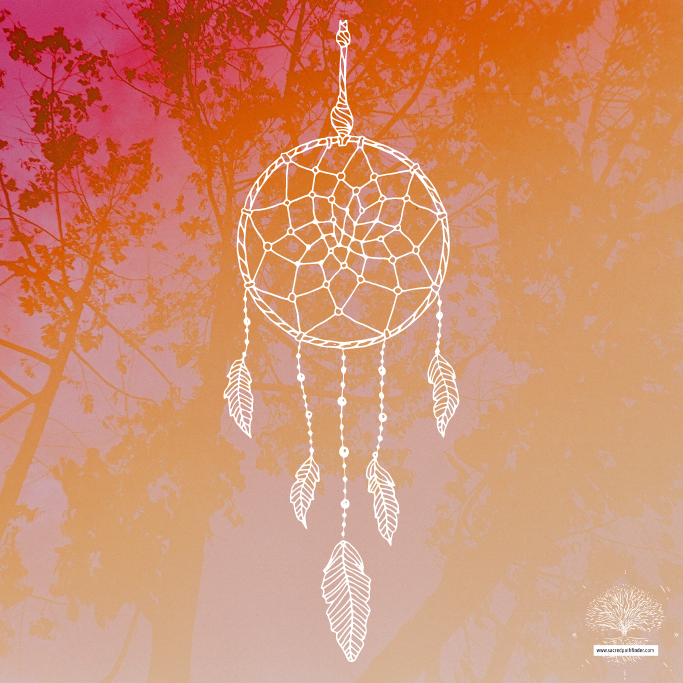
29. Dream Catcher
The Meaning
The Dream Catcher, originating from the Native American Ojibwe tribe, holds a rich origin and profound symbolism in native cultures. Traditionally made of a hoop adorned with a woven web and various sacred items such as feathers and beads, the Dream Catcher is believed to filter out negative dreams and allow positive ones to pass through.
It symbolizes protection, guidance, and spiritual awakening. The web of the Dream Catcher represents the interconnectedness of all life and the unity of the physical and spiritual realms.
The feathers attached to it symbolize the breath of life and the connection to the divine.
The Dream Catcher serves as a powerful symbol of mindfulness and intention, reminding individuals to focus on their dreams and aspirations while filtering out negativity.
The Path
To incorporate its symbolism, reflect on the image of the web woven within the hoop, which is believed to catch and filter dreams and energies during sleep. Hang one above your bed to help reflect on the meaning of the dream catcher.
Throughout the day, bring mindful awareness to your thoughts, emotions, and experiences, seeking harmony and balance within yourself.
Embrace the symbolism of the Dream Catcher as a reminder to set clear intentions, filter out negativity, and manifest positive dreams and aspirations.
Engage in practices such as meditation, journaling, or visualization to enhance your connection with your dreams and inner wisdom.
By integrating the symbolism of the Dream Catcher into your daily life, you can move towards enlightenment by cultivating awareness, protecting your energy, and fostering a deep connection with your dreams and higher self.

30. Feathers
The Meaning
In Native American cultures, the Feather holds deep spiritual significance and serves as a symbol of enlightenment and communication with the divine. Feathers are considered sacred gifts from the bird spirits and are often used in ceremonies and rituals.
Different types of feathers carry specific meanings, depending on the bird from which they originate.
Feathers are seen as symbols of flight, freedom, and the ability to transcend earthly limitations.
They represent a connection to the spirit world, serving as messengers between humans and the divine. Feathers are believed to carry prayers, intentions, and blessings to the heavens, and their presence signifies the presence of spirit and guidance.
The Feather encourages individuals to seek spiritual growth, embrace their innate wisdom, and align with their higher selves on the path to enlightenment.
The Path
To incorporate their symbolism, reflect on the image of feathers, symbolizing a connection to the spiritual realm and the presence of higher forces.
Throughout the day, bring mindful awareness to signs and synchronicities, trusting in the guidance and support of the divine.
Embrace the symbolism of feathers as a reminder to release burdens, embrace lightness of being, and follow the path of your soul’s purpose.
Engage in practices such as meditation, prayer, or nature walks to connect with the spiritual energy of feathers and invite their wisdom into your life.
Embody the qualities represented by feathers, such as trust, intuition, and alignment with your higher self, in your thoughts, actions, and relationships.
By integrating the symbolism of feathers into your daily life, you can move towards enlightenment by cultivating awareness of divine presence, embracing your true essence, and surrendering to the flow of life.
Universal Symbols and Meanings
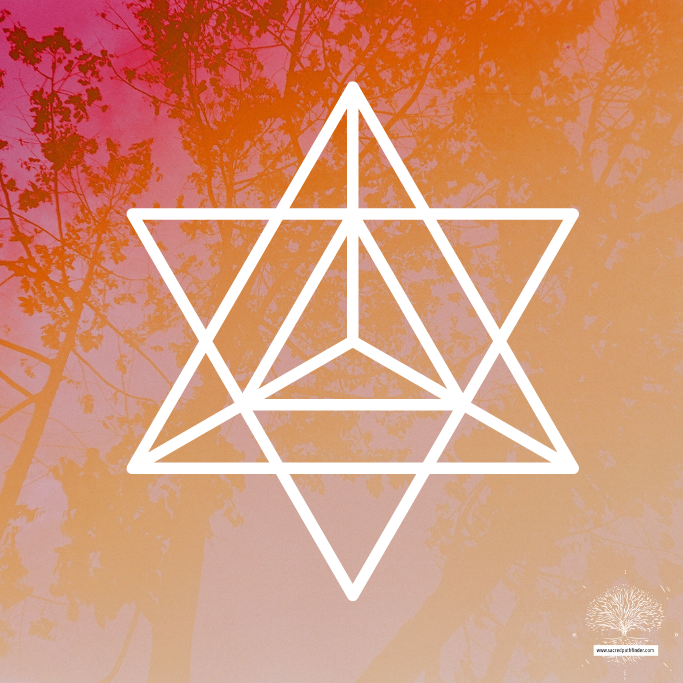
31. Merkaba
The Meaning
The Merkaba, an ancient symbol found in various esoteric and spiritual traditions, represents a powerful tool for spiritual ascension and enlightenment. Originating from ancient Jewish mysticism, the Merkaba is often depicted as a three-dimensional star tetrahedron or a vehicle of light.
Its name, meaning “chariot” in Hebrew, symbolizes the divine vehicle that transports the soul across different dimensions.
The Merkaba represents the integration of opposing forces, such as masculine and feminine, spirit and matter, and serves as a gateway to higher realms of consciousness.
By activating the Merkaba, individuals can access their inner light, transcend limited perspectives, and elevate their spiritual awareness.
It embodies the journey of self-realization and the expansion of consciousness, encouraging individuals to embrace their divine potential and navigate the multidimensional nature of existence.
The Path
To incorporate its symbolism, reflect on the image of the interlocking tetrahedrons, symbolizing the divine union of masculine and feminine energies, and the activation of the light body.
Throughout the day, bring mindful awareness to your energetic field and the balance of polarities within yourself.
Embrace the symbolism of the Merkaba as a reminder to align with your highest self and expand your consciousness.
Engage in practices such as meditation, breathwork, or visualization to activate and align your energetic field with the Merkaba’s transformative power.
By integrating the symbolism of the Merkaba into your daily life, you can move towards enlightenment by expanding your awareness, embracing the integration of opposites, and aligning with the divine flow of existence.
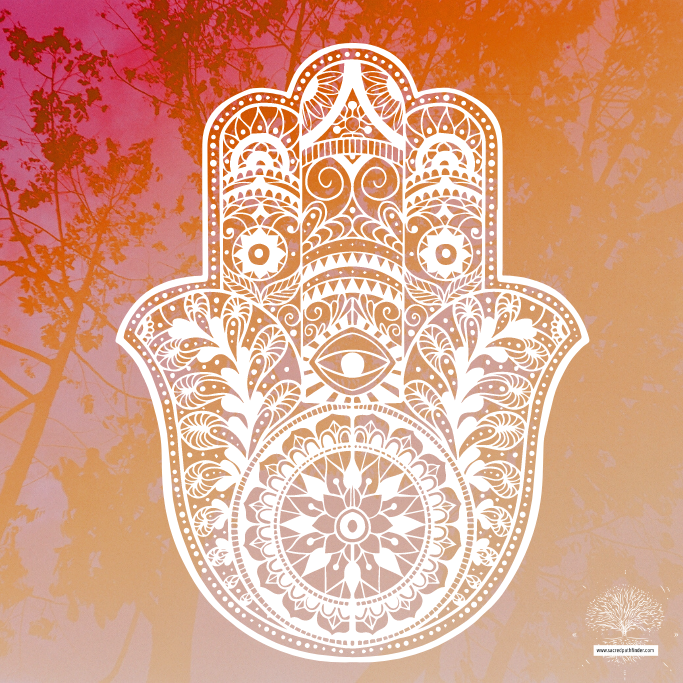
32. Hamsa
The Meaning
The Hamsa, also known as the Hand of Fatima or Hand of Miriam, is a symbol of enlightenment and protection with deep roots in ancient Middle Eastern and Mediterranean cultures.
Representing the open palm of a hand, it is believed to ward off evil and bring blessings, while also symbolizing divine guidance and inner wisdom.
The Hamsa is associated with various religious and spiritual traditions, including Judaism, Islam, and Hinduism. It signifies the interconnectedness of the divine and human realms, offering protection and spiritual awakening to those who embrace its presence.
The fingers of the Hamsa often symbolize the five senses and the five elements, reminding individuals to remain mindful and balanced in their pursuit of enlightenment.
The Hamsa serves as a powerful talisman, inviting practitioners to embrace spiritual awareness, embrace their inner divine essence, and find harmony and protection on their journey to enlightenment.
The Path
To incorporate its symbolism, reflect on the image of the hand, representing strength, power, and the interplay of divine forces.
Throughout the day, bring mindful awareness to your thoughts, words, and actions, seeking alignment with higher principles and intentions.
Embrace the symbolism of the Hamsa as a reminder to cultivate compassion, ward off negativity, and invite divine blessings into your life.
Engage in practices such as meditation, prayer, or wearing a Hamsa symbol to connect with its protective energy and invoke its blessings.
Embody the qualities represented by the Hamsa, such as purity of heart, mindfulness, and the pursuit of truth, in your daily life.
By integrating the symbolism of the Hamsa into your daily life, you can move towards enlightenment by cultivating inner strength, inviting divine protection, and aligning with the harmonious flow of existence.
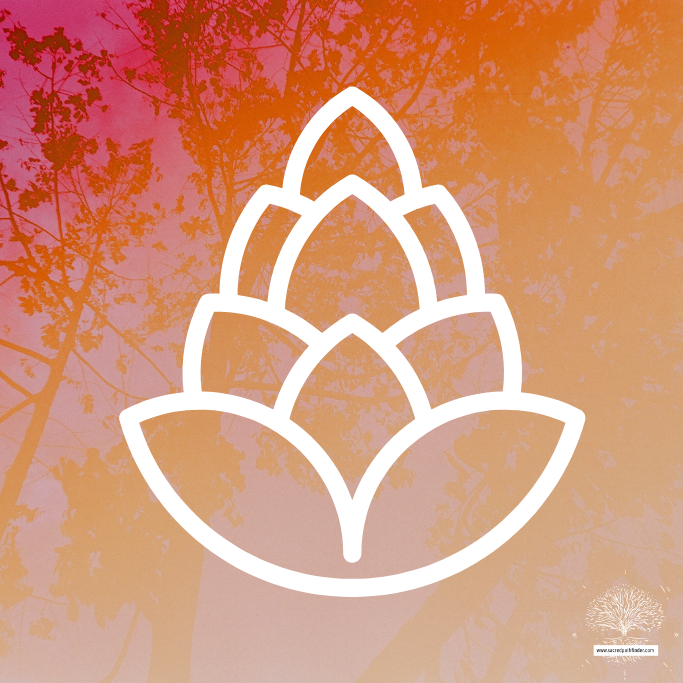
33. Pine Cone
The Meaning
The Pine Cone, also known as the Pineal Gland, has a profound origin and symbolism in various ancient cultures and spiritual traditions. It represents the seat of spiritual insight and enlightenment, often associated with the third eye and the expansion of consciousness.
In ancient civilizations, the Pine Cone was revered for its resemblance to the pineal gland, a small gland located in the center of the brain believed to be the gateway to higher states of consciousness. The Pine Cone symbolizes spiritual awakening, inner vision, and the connection between the physical and spiritual realms.
It signifies the potential for expanded awareness and the pursuit of enlightenment, reminding individuals to seek inner wisdom and align with the divine. The Pine Cone serves as a powerful reminder of the transformative journey towards self-realization and the exploration of higher dimensions of existence.
The Path
To incorporate its symbolism, reflect on the image of the Pine Cone, symbolizing the potential for inner growth and the connection between the physical and spiritual realms.
Throughout the day, bring mindful awareness to your own inner wisdom and intuition, seeking to deepen your understanding of yourself and the world around you.
Embrace the symbolism of the Pine Cone as a reminder to cultivate mindfulness, expand your consciousness, and tap into your innate wisdom.
Engage in practices such as meditation, contemplation, or connecting with nature to enhance your connection with the transformative energy of the Pine Cone.
By integrating the symbolism of the Pine Cone into your daily life, you can move towards enlightenment by nurturing your spiritual growth, seeking inner wisdom, and aligning with the cycles of nature.

34. Triangle
The Meaning
The Triangle symbol, with its origins in ancient civilizations across the globe, holds significant meaning in relation to enlightenment and spiritual growth. The triangle represents harmony, balance, and the trinity of mind, body, and spirit.
In many traditions, an upright triangle signifies aspiration and reaching toward higher realms of consciousness, while an inverted triangle represents the descent into the material world for spiritual experience and transformation.
The Triangle symbolizes the integration of opposites, such as the divine and the earthly, the masculine and the feminine.
The Triangle symbol invites individuals to explore the balance between the physical and the spiritual and to strive for unity and enlightenment through the integration of diverse elements and energies.
The Path
To incorporate its symbolism, reflect on the image of the Triangle, representing the trinity of existence.
Throughout the day, bring mindful awareness to the balance of energies within yourself and in your interactions with others.
Embrace the symbolism of the Triangle as a reminder to cultivate equilibrium, integrate opposing forces, and seek harmony in all aspects of your life.
Engage in practices such as meditation, yoga, or visualization to connect with the energy of the Triangle and harmonize your being.
By integrating the symbolism of the Triangle into your daily life, you can move towards enlightenment by balancing the aspects of your being, aligning with universal principles, and embracing the interconnectedness of all things.

35. Torch
The Meaning
The Torch symbol, with its origins in ancient civilizations, carries profound meaning in relation to enlightenment and illumination.
Representing the flame of knowledge, the torch serves as a beacon of light in the darkness.
The symbol signifies the pursuit of truth, wisdom, and the transcendent nature of consciousness.
The Torch is often associated with the guidance and inspiration provided by enlightened beings. It invites individuals to seek inner illumination and to share their light with the world.
By embracing the Torch, individuals embark on a journey of self-discovery, seeking enlightenment and spreading their radiance to illuminate the paths of others.
The Path
To incorporate its symbolism, reflect on the image of the Torch, symbolizing the light that dispels darkness and leads the way.
Throughout the day, bring mindful awareness to your own inner light and wisdom, seeking to illuminate the path before you.
Embrace the symbolism of the Torch as a reminder to ignite the flame of knowledge, truth, and compassion within yourself and others.
Engage in practices such as meditation, self-reflection, or studying spiritual teachings to deepen your connection with your inner light.
By integrating the symbolism of the Torch into your daily life, you can move towards enlightenment by seeking truth, dispelling ignorance, and shining your light in the world.

36. Spiral
The Meaning
The Spiral symbol is one of the oldest and most universal symbols found across ancient cultures worldwide, representing profound spiritual and transformative meaning. Its origin can be traced back to ancient cave paintings and rock carvings.
The Spiral represents the cyclical nature of life, growth, and spiritual evolution. It symbolizes the journey inward, the unfolding of consciousness, and the continuous process of self-discovery and enlightenment.
The Spiral’s shape, which expands or contracts as it winds, signifies the expansion of awareness and the contraction of focus on the path of enlightenment.
The Spiral symbol invites individuals to embrace change, embrace their inner wisdom, and embark on a transformative journey of self-realization and spiritual growth.
By following the Spiral, individuals can navigate the twists and turns of life, find balance, and connect with the eternal cycle of creation and renewal.
The Path
To incorporate its symbolism, reflect on the image of the Spiral, symbolizing the unfolding journey of life and the continuous process of spiritual development.
Throughout the day, bring mindful awareness to the cyclical nature of existence and the patterns of growth and transformation within yourself and the world around you.
Embrace the symbolism of the Spiral as a reminder to embrace change, release old patterns, and embrace the natural cycles of life.
Engage in practices such as meditation, self-reflection, or creative expression to connect with your own evolutionary path.
By integrating the symbolism of the Spiral into your daily life, you can move towards enlightenment by embracing the transformative power of growth, aligning with the flow of life, and recognizing the interconnectedness of all beings.

37. Cairn
The Meaning
The Cairn symbol, derived from ancient cultures across the globe, holds profound meaning in relation to enlightenment and spiritual guidance. Originating from the practice of stacking stones in a deliberate manner, the Cairn symbolizes the path of self-discovery and spiritual journey.
As travelers would add a stone to the cairn to mark their presence or guide others, the symbol represents the milestones and markers along the path of enlightenment.
It signifies finding one’s way, gaining clarity, and marking progress on the spiritual quest.
The Cairn symbol invites individuals to pause, reflect, and take stock of their inner journey.
By acknowledging the Cairn symbol, individuals can find solace, direction, and encouragement on their path to enlightenment.
The Path
To incorporate its symbolism, reflect on the image of the Cairn, symbolizing a stack of stones carefully placed upon one another to mark a path or signify a sacred space.
Throughout the day, bring mindful awareness to the present moment and the steps you take on your own spiritual journey.
Embrace the symbolism of the Cairn as a reminder to cultivate balance, make intentional choices, and stay grounded amidst life’s challenges.
Engage in practices such as meditation, making your own stack of stones in nature, or mindful walking to connect with the energy of the Cairn and deepen your sense of presence.
Embody the qualities represented by the Cairn, such as patience, perseverance, and the willingness to explore new paths, in your thoughts, actions, and relationships.
The Cairn symbol acts as a reminder to trust your intuition, follow the markers along your path, and embrace the transformative power of self-discovery and spiritual growth.
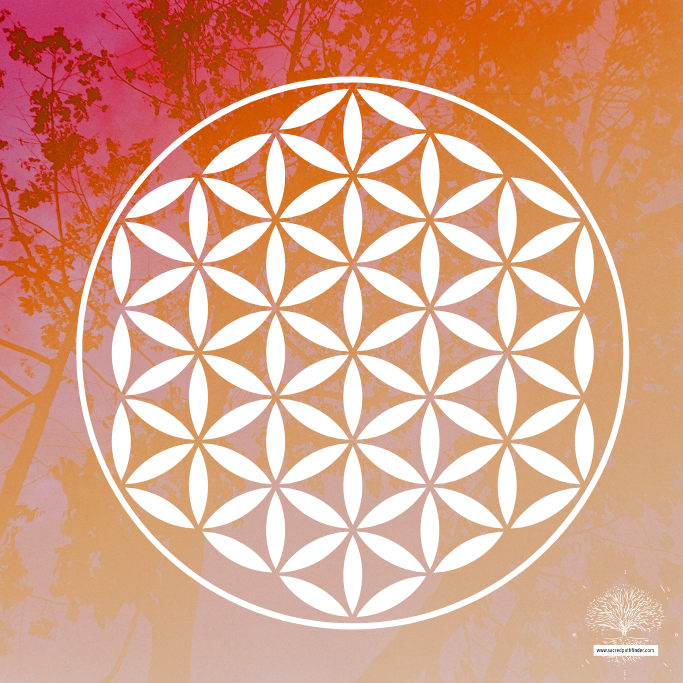
38. Flower of Life
The Meaning
The Flower of Life symbol holds ancient origins and carries deep spiritual significance. Found in various cultures and civilizations, this geometric pattern consists of overlapping circles forming a mesmerizing flower-like design.
The Flower of Life represents the interconnectedness of all living beings and the fundamental unity of existence. It embodies the divine blueprint of creation and the sacred geometry underlying the fabric of reality.
Contemplating the Flower of Life can awaken a sense of unity, harmony, and interconnectedness within individuals, reminding them of their inherent connection to the greater cosmos.
By embracing the Flower of Life, individuals embark on a journey of self-discovery, spiritual growth, and enlightenment, unlocking the profound mysteries of existence.
The Path
To incorporate its symbolism, reflect on the intricate and interconnected patterns within the Flower of Life, symbolizing the underlying structure and harmony of the universe.
Throughout the day, bring mindful awareness to the interconnectedness of all things, recognizing the beauty and sacredness of every moment.
Embrace the symbolism of the Flower of Life as a reminder to live in alignment with the universal flow, honoring the inherent unity and interdependence of all beings.
Engage in practices such as meditation, visualization, or contemplation of sacred geometry to connect with the energy of the Flower of Life and deepen your sense of oneness.
By integrating the symbolism of the Flower of Life into your daily life, you can move towards enlightenment by embracing the interconnectedness of all things, harmonizing your being, and aligning with the divine order of creation.
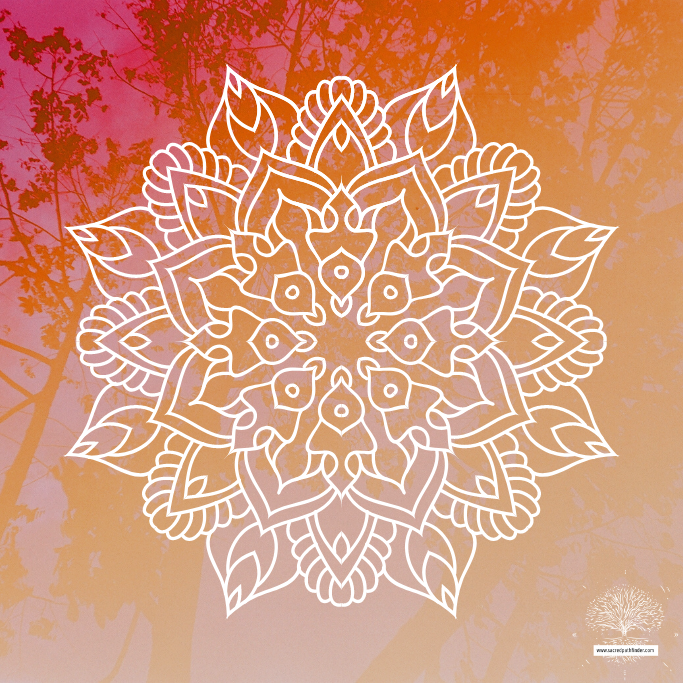
39. Mandala
The Meaning
The Mandala, originating from ancient Hindu and Buddhist traditions, holds deep spiritual significance and serves as a powerful tool for enlightenment and self-realization. The word “Mandala” translates to “circle” in Sanskrit, symbolizing the wholeness and completeness of the universe.
It is a geometric design that represents the cosmic order of all things. The intricate patterns within the Mandala symbolize the journey of self-discovery.
Creating or meditating upon a Mandala allows individuals to enter a state of deep meditation, aligning with their inner selves and the divine.
The Mandala serves as a sacred map, guiding individuals on their path to enlightenment and the realization of their true nature.
The Path
To incorporate its symbolism, reflect on the intricate and symmetrical patterns within the Mandala, symbolizing the cosmic order and the interconnection of all things.
Throughout the day, bring mindful awareness to the present moment, seeking to find balance and inner harmony.
Embrace the symbolism of the Mandala as a reminder to cultivate inner stillness, connect with your true self, and explore the depths of your being.
Engage in practices such as meditation, creating or coloring mandalas, or gazing at mandala images to enter a state of focused awareness and attunement.
By integrating the symbolism of the Mandala into your daily life, you can move towards enlightenment by embracing the inherent wholeness within yourself, finding connection with the larger cosmos, and aligning with the divine order of existence.
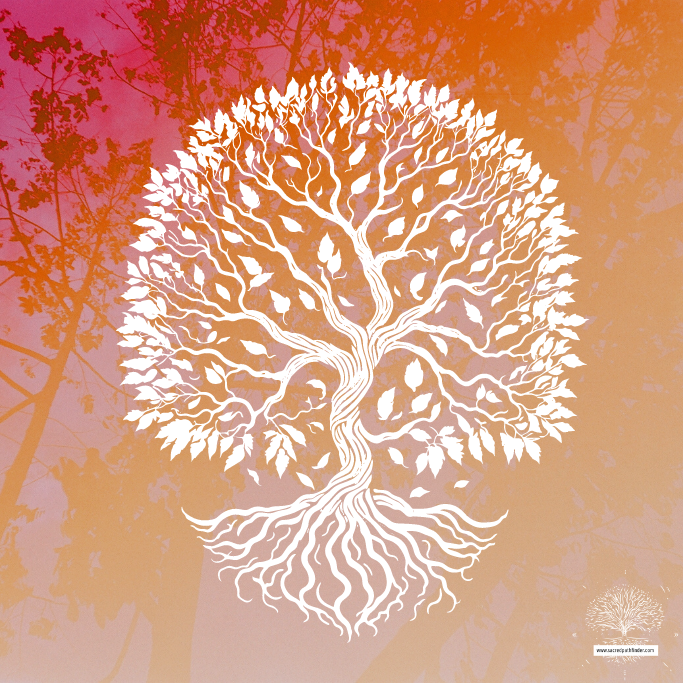
40. Tree of Life
The Meaning
The Tree of Life is a powerful symbol that holds deep roots in various ancient cultures and spiritual traditions worldwide. Found in mythologies and belief systems across different civilizations, the Tree of Life represents the interconnectedness of all life forms and the unity of the physical and spiritual realms.
With its roots grounded in the earth and branches reaching towards the heavens, it symbolizes the balance between the material and the divine.
The Tree of Life embodies growth, renewal, and the cycles of life and death.
It serves as a reminder of our connection to nature, the wisdom inherent in the natural world, and the potential for spiritual evolution.
The Path
To incorporate its symbolism, reflect on the image of the Tree, symbolizing the roots reaching deep into the earth, the trunk as a stable foundation, and the branches reaching towards the heavens.
Throughout the day, bring mindful awareness to the interconnectedness of all life forms and the cycles of growth and transformation within yourself and the world around you.
Embrace the symbolism of the Tree of Life as a reminder to cultivate grounding, nurture your roots, and reach for spiritual heights.
Engage in practices such as meditation, spending time in nature, or visualization of the Tree of Life to connect with its energy and wisdom.
By integrating the symbolism of the Tree of Life into your daily life, you can move towards enlightenment by honoring the interconnectedness of all beings, nurturing your own growth, and aligning with the sacredness of existence.
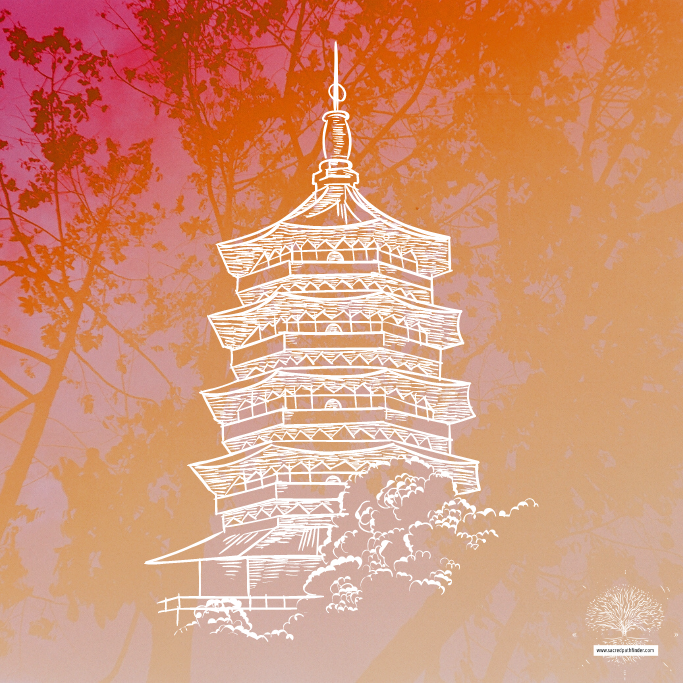
41. Pagoda
The Meaning
The Pagoda, originating from ancient Asian cultures, holds deep spiritual and symbolic significance. This architectural structure, typically characterized by multiple tiers and a pointed roof, serves as a sacred space for worship, meditation, and enlightenment.
The Pagoda’s design is believed to represent the spiritual ascent towards higher realms of consciousness. It symbolizes the connection between heaven and earth, and the layers of the Pagoda correspond to different levels of spiritual attainment.
The Pagoda’s pointed roof signifies the transcendence of earthly concerns and the journey toward spiritual enlightenment.
By engaging with the Pagoda’s sacred space, individuals are inspired to seek inner growth, cultivate inner peace, and deepen their connection to the divine.
The Path
To incorporate its symbolism, reflect on the image of the Pagoda, symbolizing a multi-tiered structure that represents the ascent to higher states of consciousness.
Throughout the day, bring mindful awareness to your own spiritual journey, seeking to elevate your thoughts and actions.
Engage in practices such as meditation, prayer, or study of sacred texts to deepen your connection with higher truths and spiritual teachings.
Embody the qualities represented by the Pagoda, such as patience, discipline, and the pursuit of enlightenment, in your thoughts, actions, and relationships.
By integrating the symbolism of the Pagoda into your daily life, you can move towards enlightenment by honoring your spiritual path, seeking higher wisdom, and aligning with the divine.

42. Sri Yantra
The Meaning
The Sri Yantra, an ancient symbol originating from Hindu and Tantric traditions, embodies profound spiritual meaning and represents the cosmic order and divine unity. Its intricate geometric design consists of nine interlocking triangles, representing the masculine and feminine energies.
The central point, known as the bindu, symbolizes the source of creation. The Sri Yantra represents the union of Shiva and Shakti, the divine masculine and feminine forces, and the harmonious balance between them.
Meditating upon the Sri Yantra is believed to awaken higher consciousness, manifest desires, and lead to spiritual enlightenment.
It serves as a tool for focusing the mind, transcending limitations, and attaining unity with the divine.
By contemplating the Sri Yantra, individuals align themselves with cosmic energy, unlock inner wisdom, and embark on a transformative journey of self-discovery and spiritual evolution.
The Path
To incorporate its symbolism, reflect on the intricate patterns within the Sri Yantra, symbolizing the divine union of the masculine and feminine energies, and the manifestation of the universe.
Throughout the day, bring mindful awareness to the balance of energies within yourself and in your interactions with the world.
Engage in practices such as meditation, visualization, or chanting sacred mantras associated with the Sri Yantra to deepen your connection with its energy and sacred geometry.
By integrating the symbolism of the Sri Yantra into your daily life, you can move towards enlightenment by embracing the interconnectedness of all things, honoring the divine within yourself and others, and aligning with the cosmic order of the universe.

43. Skulls
The Meaning
The Skull symbol, with its origins in various ancient cultures, holds multifaceted meanings in relation to enlightenment and spiritual contemplation. In some traditions, the Skull symbolizes the impermanence of life and the transitory nature of human existence.
It serves as a potent reminder of the inevitability of death and the importance of embracing the present moment. The Skull symbol can also represent the concept of memento mori, encouraging individuals to reflect on their mortality and prioritize spiritual growth and inner transformation.
It serves as a symbol of liberation from attachment to the physical world and the ephemeral nature of material pursuits.
By embracing the Skull symbol, individuals are reminded to live fully, cultivate spiritual awareness, and seek enlightenment in the face of life’s impermanence.
The Path
Incorporating this symbol into daily life requires approaching it with deep contemplation and mindfulness. Reflect on the transient nature of existence and the inevitability of mortality.
Embrace the symbolism of the skull as a catalyst for letting go of attachments, fears, and egoic identities, and instead focusing on the essence of life and the present moment.
Engage in practices such as meditation, reflection on impermanence, or rituals that symbolize the dissolution of the ego.
The skull symbol acts as a powerful reminder to honor the preciousness of life, embrace the impermanent nature of existence, and awaken to the transformative power of self-discovery.

44. The Sun
The Meaning
The symbol of the sun, revered across numerous ancient cultures, holds profound significance in relation to enlightenment and spiritual illumination. Originating from the earliest human civilizations, the sun represents the source of light, warmth, and life-giving energy.
It symbolizes the divine presence, wisdom, and enlightenment. The sun’s radiant energy is often associated with the awakening of consciousness and the pursuit of higher knowledge.
In many cultures, the sun is seen as a powerful deity, a guiding force that brings clarity, vitality, and spiritual growth.
The symbol of the sun serves as a reminder to seek inner light, embrace the power of divine illumination, and harness the transformative energy of enlightenment.
By connecting with the symbol of the sun, individuals are inspired to radiate their inner light, embrace their true potential, and align with the universal wisdom that guides the path of spiritual awakening.
The Path
To incorporate its symbolism, reflect on the radiance and life-giving energy of the Sun, which represents the source of all life.
Throughout the day, bring mindful awareness to the present moment and seek to cultivate inner radiance and vitality.
Embrace the symbolism of the Sun as a reminder to shine your authentic light, embrace your unique gifts, and express your true self.
Engage in practices such as sun gazing, meditation on the Sun’s energy, or visualization of absorbing its nourishing rays to connect with its transformative power.
By integrating the symbolism of the Sun into your daily life, you can move towards enlightenment by cultivating inner radiance, expanding your awareness, and aligning with the divine source of light and life. And if you want to learn more about sun and moon symbolism, check out this article.
Conclusion
Are you feeling inspired by the ancient symbols for enlightenment discussed in this article?
Subscribe to our newsletter to receive regular updates on spiritual wisdom, practices, and guidance.
We invite you to share your experiences and insights with us, and let us know which symbol resonates with you the most. Together, let’s embark on a journey of self-discovery and growth.

